Sometimes You Just Can't Go Back...So Much for the NASB

And such is life.
Kathy sat me down on the couch this morning, and in no uncertain terms told me, “You can’t teach with whatever translation you’ve used the last two Sundays anymore!”
“Why not?” I sheepishly asked. Although I knew better. I had read the word “booty” from that Bible in front of forty people in our Bible study to the snicker of some and to the red face of my wife. Who uses that word anyway--pirates?
She went on to tell me that every time I read anything from my Bible, it was hard to understand and too different from anything anyone else was reading from. She said, “No one could even follow you!”
I reached for the Bible to which she was referring. I opened it up and showed it to her. “But I like this Bible. It has wide margins. I teach better when I use it.”
“Better for you, maybe, but not for anyone else. So you have to decide--are you going to teach in a way that’s easier for you or easier for those listening to you?”
Here’s what happened: two weeks ago, I did the unthinkable--I went back to my NASB for teaching our Sunday morning Bible study. I taught from the NASB for almost two decades, and then in 2005, while teaching a half year study on Romans, I realized I was spending more time explaining the English of the NASB than explaining what Paul actually said in Romans. I have always been an advocate of modern language translation, but I always felt that in a teaching setting, I would be able to use something a bit more formal. I quit doing that in 2005.
Since then I’ve used a variety of translations--going first to the HCSB and then the TNIV as my primary teaching Bible, but also using the NLT quite a bit and even the NET Bible.
...But I was frustrated. Part of my method all those years involved taking notes in a wide margin edition, and then using that edition when I’m teaching. I carried notes on paper, too, but the subset in my margins were little reminders of the most important information to get across.
Two decades ago, my goal had been to study biblical languages to the point that I no longer needed translations at all. I always carry at least my Greek New Testament with me, but I have two problems with totally abandoning English translations: (1) I simply don’t have every word in the NT in my working vocabulary. Yes, I can prepare a passage beforehand to teach from. But the first time I think of another passage to look at, or the first time someone says, “What about this verse?” I look at that and can translate everything except those two words. So it’s never been practical on the fly to try do that exclusively--at least not yet. And (2), I’m hopefully a bit humbler now, but I recognize that my “on the fly” translation, even if I know every word, is not necessarily better than a standard translation produced by a committee made up of people who are surely smarter than me.
So I continue to use both, using a translation as a primary text when I’m in front of others.
After abandoning the NASB, the translation I’d used since I was thirteen-years-old, I assumed I’d be able to get one of these more modern translations in a wide-margin edition. No such luck. So I thought I’d be patient and wait, but now after three and a half years, still no luck.
Sunday before last, I did what I had been tempted to do many times before, I taught from my trusty old Foundation Press wide-margin NASB. It felt good. I felt like I was spending time with an old friend. And even teaching from Isaiah 38-39, I managed to get away with it, partly by letting people in my class read sections that were...what can I say...a bit awkward sounding. But I made it, I felt like I was a better teacher, and I planned to go on and use my trusty NASB for a second week.
Then this past Sunday, we were running short of time as is often the case. With only a couple of minutes to go, I offered to read vv. 11-12 of Isaiah 53. As I begin to read...As a result of the anguish of His soul...I can already see it upcoming in v. 12 in my peripheral vision. My Servant, will justify the many, As He will bear their iniquities... This is what I noted in my preparation that I absolutely must not read publicly...Therefore, I will allot Him a a\portion with the great... I tried to think of all the other translations that I looked at ahead of time. What word did they use for שָׁלָל? Spoil (HCSB, ESV, JPS, NKJV, NRSV, REB), spoils (TNIV, NET)...it was right there swimming about my brain, but I couldn’t remember. And then I read it... aloud:
And He will divide the booty with the strong
I heard chuckles. I could see heads lifting up, including my wife’s. I knew what they were thinking. Did he just say... ? Surely not. No one except for teenagers and pirates say that.
So, the heart-to-heart talk this morning came as no surprise. She had all the conviction of Sarah telling Abraham that Hagar had to go, so who was I to argue with her?
So, I’ll go back to my non-wide-margin Bibles, and wait hopefully that one day, I’ll get a wide margin Bible in a modern translation. But what do I use this Sunday? For the last couple of years, I’ve used TNIV on Sundays mostly, and the NLT during the week. But sadly, I have doubts about the staying power of the TNIV. So maybe this is simply the time to switch.
I use the NLT with my college students midweek because not all of them are believers, and the NLT has the most natural conversational English of any major translation. As I used it tonight with a class, I had to ask myself why I couldn’t use it on Sunday mornings, too? And I don’t have a good answer for that. So maybe this is the crossroads in which I simply need to make the NLT my primary public use Bible. I may have been held back by nothing more than my own traditionalism, but after listening this past week to Eugene Peterson’s Eat This Book, I’m more convicted than ever to present the Scriptures in common, ordinary language, and not the language of heavenly-portals-loud-with-hosannas-ring.
But what do I use? There’s still no wide-margin NLT. I’d certainly want the 2007 edition. So what are my options?
Trans. Abbrev. Conf.
Abbreviations are a helpful thing. When talking about Bibles, it's much easier to simply write "NLT" than New Living Translation every I want to reference it.
I don't always remember to do it, but when writing a blog entry that refers to a translation, I try to write it out the first time I reference it along with the abbreviation in parentheses which I simply use from that point forward.
With the advent of the New American Standard Bible in the 1970's we got the four-letter abbreviation, "NASB," followed by the NKJV, NRSV and now the HCSB (which we have recently heard is going to soon be reduced to simply the three-letter "CSB").
A lot of us who discuss translations regularly take these abbreviations for granted, but surely they cause confusion now and then to the unititiated.
So as excited as I was to see the release of the New English Translation of the Septuagint (which in my opinion is the first significant English translation of the Septuagint since Brenton's of 1851), I was very disappointed in its acronym: NETS. And yes, that IS the acronym as it is set by the publishers on the copyright page with the statement:
"A New English Translation of the Septuagint may be quoted in nonsalable media (such as church bulletins, orders of service, liturgies, newsletters, etc.) without inclusion of a copyright notice, but the abbreviation NETS must appear at the end of each quotation."
What's the problem with "NETS"? Well, to me, it is way too close to NET (New English Translation) which was already too close to NEB (New English Bible).
NEB = New English Bible
NET = New English Transltion
NETS = New English Translation of the Septuagint
And, of course, none of these three translations have anything to do with the others.
I wonder where all the creativity has gone in naming translations. I also wonder if the NET Bible was even on the radar of the NETS editors when they came up with the name. Although I personally consider the NET Bible a major translation (and my review is finally in the works), it has not received the exposure it deserves because it (to my knowledge) is only available through mail order.
Some might feel the nearness of the acronyms to the NEB is a non-issue because it is now nearly four decades from its last edition before the REB. However, I still occasionally come across NEW reference books that refer to the NEB--sometimes in EXCLUSION to the REB which has been available for almost two decades!
So, I see room for all kinds of abbreviation confusion, especially between the NET and NETS. And one would think that with 26 letters of the alphabet, we could come up with a few more unique combinations!
The Best Bible Translation
I do not really believe that there is a BEST translation out there for all people, preferring to ask, “Best for what?”
When studying the Bible, my habit is to start with the original languages (especially with the NT as my Greek is much stronger than my Hebrew), and first work out my own translation. I admit that I don't always do this, especially if I'm about to teach a "well known" passage--that is, one that I've taught before. But when I have the time, I find great value with beginning with the original languages, and then referencing English translations as well. I find that the nuances between translations help me better understand the original languages themselves, especially if there’s great difference from my own translation.
My Core Translations. I have a “core” of first-level English translations I refer to which I believe span the range from formal to dynamic. On the formal side, I will read from the New American Standard Bible (NASB), which is also the Bible in which I still make my “permanent” notations in its wide margin. In the median range, I consult both the Holman Christian Standard Bible (HCSB) and Today's New International Version (TNIV), two very good recent translations, but with different approaches to translating gender in some passages. On the dynamic range, I take a look at the second edition of the New Living Translation (NLT). The scholarship is very solid in this translation, and sometimes its dynamic flavor actually brings out the meaning of the passage better than more literal translations.
Secondary Translations. If I have time, I have a secondary tier of translations that I will consult from including the New English Translation (NET or NET Bible), New Revised Standard Version (NRSV), English Standard Version (ESV), the TANAKH from the Jewish Publication Society (JPS), Revised English Bible (REB), King James Version (KJV) and occasionally a few others. I don't have a large KJV constituency in the groups I teach, but if I did, I would probably move it to the core translations I look at. As for the NET Bible, I like the notes so much that I often consult them early when studying a passage, sometimes before I hit commentaries and other reference works in order to get a quick history of textual issues and interpretation.
Physical vs. Electronic. When I study a passage, I don’t have dozens of Bibles in front of me as I tend to use parallel panes in Accordance for a lot of this work. I may have a Greek NT in front of me because I sometimes like to make notes about the grammar or a word or phrase in the margin. Interpretive and explanatory notes I’ll write down in the wide margin NASB that I’ve already mentioned. And I might also have a TNIV with me since in the last year and a half I primarily have begun to use this when teaching or preaching in public. The margins in my TNIV are much more narrow than those in my NASB, so I can add a few notations, but I have to be selective.
Primary Bible Recommendations. When people ask me to recommend a translation, currently I am only recommending the HCSB, NLT and TNIV as a primary Bible, although I do suggest getting a good formal equivalent Bible such as the NASB to read in parallel. These three that I recommend also happen to be the three that I mostly use in public. Most of the time I teach out of the TNIV. However, sometimes in my preparation, I find a passage in the HCSB that simply seems to be rendered more accurately and I'll opt for that. When speaking in front of groups that I believe may include those who are not Christians or those with less background in the Bible, I often opt for the NLT because it is much closer to conversational English than other translations. For Catholic believers, I recommend the New Jerusalem Bible (NJB) over the New American Bible (NAB). The NRSV has the widest collection of Intertestamental books of any translation, with which more Christians should acquaint themselves.
Best for Children. I still believe the Good News Translation (GNT), especially one with the line drawing illustrations, is the best translation for a child who is just learning to read. Sadly, though, these are becoming more difficult to find.
Favorite for Reading. My favorite Bible strictly for reading is the REB, which is undoubtedly the best literary translation of the Bible since the KJV, but without the archaic baggage.
For more information, consult my series on my "Top Ten Bible Versions."
Note: This post is an expansion of a comment I left over at Said at Southern.
Intelligible Is Not Preferred If the Rendering Is Inaccurate: Matthew 16:18-19 in the TNIV
Our focal text for the day was Matthew 16:13-28. As I do on most Sundays, I was teaching from the TNIV. When I'm teaching, I prefer not to have to undermine the translation I'm using in order to clarify actual meaning in the text. But the TNIV was lacking, in my opinion, in two very important places in our study. Had I been thinking, I probably should have grabbed my HCSB when I walked out the door as it was much better.
First, I'm not fond of the rendering in v. 18: "and the gates of death will not overcome it" (emphasis added). The original NIV simply had Hades here, transliterated from the Greek. On the one hand, hell (KJV, NLT) is too strong of a translation. But in my opinion, the TNIV's death lacks a certain amount of punch. Hades certainly does carry the meaning of death, and at times could be legitimately translated simply as death or grave (Acts 2:27 for instance, although here the TNIV ironically uses "the realm of the dead"). But my concern with death in Matt 16:18 is that the reader will miss the spiritual aspect of Jesus' words. Yes, I know that theologically speaking, all death is a spiritual event. But many don't realize that and merely see it as a physical act at the end of existence.
I perfectly realize that Hades by itself isn't any clearer and many will still need explanation, but again, I feel that death simply doesn't say enough while hell overreaches. I know that many readers will disagree with me and see death as a fine translation. Please realize, I'm not calling it inaccurate, just less effective and incomplete. But that does lead to the next issue where I believe there is an actual inaccuracy in the TNIV (and the majority of translations in use today).
I was disappointed in v. 19 to see that the future perfect aspect of binding and loosing that is in the Greek (δεδεμένον and λελυμένον, respectively) were ignored in favor of a fairly traditional rendering: "whatever you bind on earth will be bound in heaven, and whatever you loose on earth will be loosed in heaven.” But if misery loves company, very few translations render this correctly. In fact, only three major modern translations even attempt to bring out an accurate understanding of the passage:
“...and whatever you bind on earth shall have been bound in heaven, and whatever you loose on earth shall have been loosed in heaven.” (NASB) “...and whatever you bind on earth is already bound in heaven, and whatever you loose on earth is already loosed in heaven.” (HCSB) "Whatever you bind on earth will have been bound in heaven, and whatever you release on earth will have been released in heaven." (NET)
Certainly, the alternatives above are a bit more awkward, but the difference theologically is enormous, and more importantly, they are more accurate. So, since I have said before that "literal is not more accurate if it's unintelligible," I might also suggest that intelligible is not preferred if the rendering is inaccurate.
It cuts both ways.
Final note: alternate (and more accurate) renderings for v. 19 are found in some translations including the ESV and TNIV:
Or shall have been bound . . . shall have been loosed (ESV)
Or will have been. (TNIV)
CBA Updates Bible Translation Rankings & Method for Rankings [UPDATED]
After an unexplained absence the last couple of months, the Christian Booksellers Association (CBA) has now posted Bible translation rankings for the month of November. Perhaps responding to previous criticisms for the way reports are calculated, the CBA rankings have now been separated into two separate lists: one by dollar sales and one by volume sales.
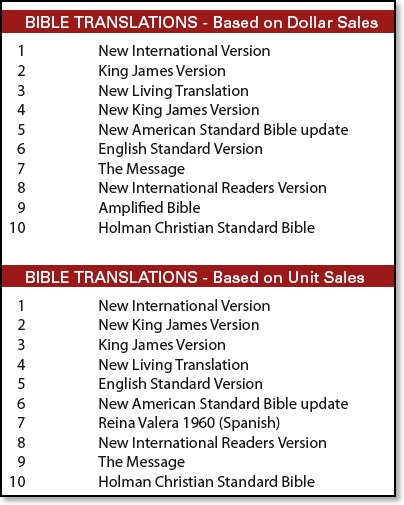
This change is certainly welcome because the two separate lists tell us exactly what we're seeing. Of course, I'd like to see the actual numbers of unit sales as my hunch is probably 75% of all units sold are represented in the first two or three listings. The other issue readers need to keep in mind is that these sale are only reflective of CBA member stores. Thus, significant numbers are not included from such outlets as Wal-Mart, Amazon.com, book chains such as Barnes & Noble and all other non-CBA member businesses.
Whatever Happened to the CBA Bible Translation Bestseller List?

It's been MIA for two (or is it three?) months now.
I've been watching the list on and off since 1986 when I got my first job in a Christian bookstore. Although it's been quite a while since my last bookstore gig, at various times, I worked at three different companies (including one national chain and two independents, all CBA members), and I used to regularly cut the chart out of the back of the CBA Journal and frame it next to the Bible section.
Of course, no one ever really thought the rankings were overly accurate. I've even had publishing insiders tell me how poorly configured it was. But I had also heard that an improved system was in the works. And now suddenly it's gone! Yet surprisingly, if you follow the link above, the CBA is still tracking other Bible sales. How come they can't track translations anymore?
What have you heard?
Plural "You" in John 1:51

My third point, drawn from John 1:47-51, I labeled "Be ready for the unexpected." In my initial study of this passage, I noticed that in the Greek that in v. 51 Jesus shifts from simply addressing Nathaniel to addressing other disciples who were presumably present. Translating a plural you into English can be a bit tricky since we technically don't have a separate word in standard English for the second person plural. A fairly literal translation of this verse would read something like this:
And he said to him, "Truly, truly I say to y'all [ὑμῖν], y'all will see [ὄψεσθε] heaven open...
Of course, I can translate with y'all because I grew up in the south. And I should also mention that the KJV communicates the second person plural (at least clearly in the second instance) because Elizabethan English also allowed for the distinction by using the now archaic ye:
And he saith unto him, Verily, verily, I say unto you, Hereafter ye shall see heaven open (John 1:51 KJV)
Regardless, when there is a shift of person in the Bible such as that in v. 51, I readily admit that it's not always significant. But here I believe it is. Jesus' message of what a disciple would experience was not something meant for Nathaniel alone. A few translations make an effort to represent the second person plural, but most traditionally have not. Originally, I had been planning to use the NLT for this message, not only because I believe it communicated the entire passage well, but especially because it brought out the plural "you" here:
Then he said, “I tell you the truth, you will all see heaven open... (John 1:51 NLT)
However, then on Friday, I received my copy of the NET Readers Bible in the mail. Looking at the passage and especially v. 51, I was pleased to see the second person plural rendered here as well:
He continued, “I tell all of you the solemn truth–you will see heaven opened... (John 1:51 NET)
Thus I began my little "NET for a month" experiment and preached from it on Sunday.
I should point out that a number of other translations mention the plural "you's" in the footnotes, including the ESV, HCSB, NRSV, NIV and TNIV. The REB is another translation that renders the plural in the actual text.
So which is better: text or notes? I would suggest that the better rendering is when it can be done in the text for the sake of those listening without a Bible in front of them.
Feel free to leave your opinion in the comments.
Forthcoming Wide-Margin Bible Survey Update
Here's where you can help me. Take a look at the original post linked in the above paragraph. If you know of any new wide-margin Bibles that have been released, please leave the information in the comments below so I can include it.
Also, although I opted not to include KJV offerings last time, I occasionally get emails asking about KJV wide-margin Bibles. I still don't recommend the KJV as a primary study Bible, which is why I didn't list them last time. However, I am considering adding them to the new survey, so if you know of some specific KJV wide-margins out there, please let me know--especially if you can give descriptions of them.
Newest Acquisition: the Twentieth Century New Testament
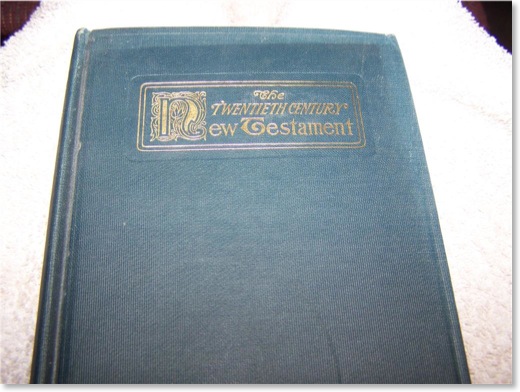
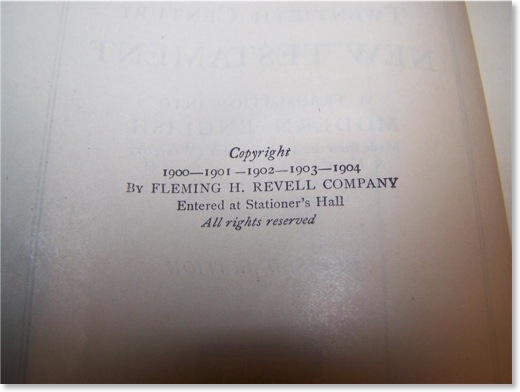
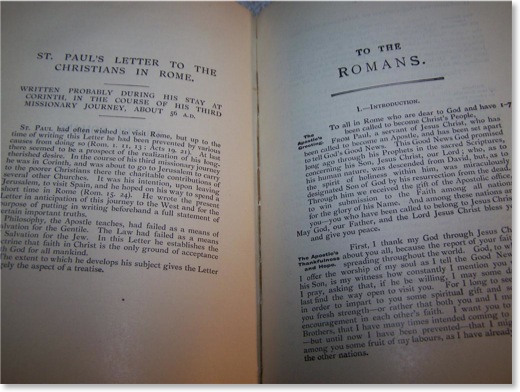
I haven't had a whole lot of time to spend with it yet, but I note that the gospels begin with Mark under the conviction that this was the first gospel written. Also Paul's letters begin with 1 Thessalonians since most believe this was the first letter written by Paul. Also it's worth noting that James is included before Paul's letters.
The Twentieth Century New Testament (TCNT) shows a concern almost a century old that the KJV used outdated and archaic language with the risk that modern readers exposed only to the 1611 translation might consider the Bible to be irrelevant, merely an ancient document of history. It's also worth noting that the TCNT is one of the first translations based on the Westcott and Hort text.
I ran a search for the title through the theological journals I have in Accordance and I found a review in Bibliotheca Sacra from 1963. The review itself, written by S. D. Toussaint, was in reference to a recent Moody Press reprint of the TCNT. Below is an edited version of the review with pertinent information retained:
This is not a mid-twentieth century translation but a pre-twentieth century work based on the text of Westcott and Hort. It [was] first published in 1900 and made by twenty unnamed men and women from “various sections of the Christian Church.”
The 1900 publication has the books arranged in a chronological order. Significantly, Mark is given as the earliest gospel; strangely, Titus is placed after 2 Timothy. [The TNTC provides] an introduction to each book containing data concerning authorship, date, sources, etc. Some of these occasionally reveal a liberal view. (In the introduction to Revelation it is stated concerning its authorship, “There is at present no certain clue to his identity").
...The preface of the original translation...does not claim this is a verbal translation but it also denies being a paraphrase. It asserts: “…The effort has been made to give the exact force and meaning in idiomatic modern English.” Despite this fact, it definitely tends toward a paraphrase. Aside from this shortcoming, the translation does have a number of advantages. The books are divided into sections and paragraphs; outlines are incorporated into the books; quotations are indicated by finer print; and measures, values, and titles are given in the nearest English equivalents.
This translation may prove to be useful to the Bible student who would like to add another translation to his already extended shelf of “twentieth century” renditions.
GUEST REVIEW: The New Life Version
Review of the New Life Version of the Bible
by Claudio Duckardt

As I said, I was raised on the KJV, but rarely read more than a few verses in one sitting since I could not understand many of the passages. For years, I neglected much of the Bible, especially the Old Testament. I will never forget how excited and happy I was when I discovered modern versions. These Bibles made God’s word understandable, warm, alive, and personal. I finally learned what the Bible was all about. Sure, the KJV-only camp criticized me, but I didn’t care. I am in complete agreement that language is fluid, and God’s word must reflect these updates or His message will become obscured.
One thing that has always bothered me, however, is the textual issue. As you know, the KJV is based on the received (or traditional) text while most modern translations are based on the critical one. As a result, many verses found in the KJV are not found in the body of most modern translations. Don’t get me wrong…. all mainstream Bible translations are God’s word. I am not suggesting that one stream of manuscripts is better or worse than the other. Yet, I have often thought that there should be a dynamic equivalent translation follows the received text. We as Christians owe it to ourselves to have Bibles from both streams. After all, the superiority of one text over the other is based on theory. Sure, the NKJV was translated from the traditional text, but can also be a difficult read. I have often thought it would be nice to have a dynamic equivalence Bible based on the traditional stream of texts.
Well, there is and has been an easy-to-read Bible that is very similar in spirit to the traditional family of English Bibles, the New Life Version. This version uses a base of only 850 vocabulary words (not including names of people and places) in its text. It is not a direct translation from the Hebrew and Greek. Instead, it was “translated” from a more literal Bible into simple English, with most received text readings in place. The reader my be thinking “Ah ha! Paraphrase!” but it is actually pretty accurate. While the preface and official website (www.newlifebible.org) does not say which version was used, this Bible seems to use the KJV as its basis. The NLV is not well known, but has been available in its complete form since 1986.
At first glance, this version may seem like just another paraphrase. It is much more than that. First, a little history about the NLV. Between 1946-1961, a Canadian missionary couple, Gleason and Kathryn Ledyard, had the privilege of spreading the Gospel to Eskimos that lived in the Canadian artic. They actually lived in igloos with the Eskimos! Mr. Ledyard had a strong desire for the natives to read a Bible in simple English. The versions available at that time were not approachable by new English speakers. Together with his wife, he decided to simplify the text to make the Bible more accessible to their Eskimo friends. However, the couple had a few rules. First of all, no changes would be made to the text in order to avoid making the version a paraphrase. Second, no footnotes would be included. All of the verses (again, as in the KJV) would be included in the text, but asterisks and parenthesis would be used to indicate readings not in some of the ancient witnesses (even though critical text readings are used in some instances). Thirdly, other than proper names of people and places, only 850 Basic English words would be used. Their version of the New Testament was completed in 1969. The Old Testament followed a few years later. Their completed Bible was completed in 1986.
Some Bible terms were simplified to make it more understandable. “Noah’s ark” becomes “Noah’s boat”; “Gentiles” become “people who do not know God or are not Jews”; “glory” becomes “shining-greatness”; “idolatry” becomes “worshiping false gods.” While some of these terms seem childlike, it must be remembered that originally this Bible was designed for beginning English speakers.
STRENGTHS OF THE NLV
The main strength of this version its use of simple sentences and vocabulary. This makes the NLV great for people who have never read the Bible or speak English as a second language. Difficult terms are simplified (much like the NLT). Let me compare a few verses between the KJV and NLV.
GENESIS 3:1-5 |
|
KJV |
NLV |
| 1 Now the serpent was more subtil than any beast of the field which the LORD God had made. And he said unto the woman, Yea, hath God said, Ye shall not eat of every tree of the garden? 2 And the woman said unto the serpent, We may eat of the fruit of the trees of the garden: 3 But of the fruit of the tree which is in the midst of the garden, God hath said, Ye shall not eat of it, neither shall ye touch it, lest ye die. 4 And the serpent said unto the woman, Ye shall not surely die: 5 For God doth know that in the day ye eat thereof, then your eyes shall be opened, and ye shall be as gods, knowing good and evil. | 1 Now the snake was more able to fool others than any animal of the field which the Lord God had made. He said to the woman, "Did God say that you should not eat from any tree in the garden?" 2 Then the woman said to the snake, "We may eat the fruit of the trees of the gar-den. 3 But from the tree which is in the center of the garden, God has said, 'Do not eat from it or touch it, or you will die.' " |
EXODUS 3:11-14 |
|
KJV |
NLV |
| 11 And Moses said unto God, Who am I, that I should go unto Pharaoh, and that I should bring forth the children of Israel out of Egypt? 12 And he said, Certainly I will be with thee; and this shall be a token unto thee, that I have sent thee: When thou hast brought forth the people out of Egypt, ye shall serve God upon this mountain. 13 And Moses said unto God, Behold, when I come unto the children of Israel, and shall say unto them, The God of your fathers hath sent me unto you; and they shall say to me, What is his name? what shall I say unto them? 14 And God said unto Moses, I AM THAT I AM: and he said, Thus shalt thou say unto the children of Israel, I AM hath sent me unto you. | 11 But Moses said to God, "Who am I to go to Pharaoh and bring the people of Israel out of Egypt?" 12 God said, "But I will be with you. And this will be something special for you to see to know that I have sent you: When you have brought the people out of Egypt, you will worship God at this mountain." 13 Then Moses said to God, "See, I am going to the people of Israel, and I will say to them, 'The God of your fathers has sent me to you.' Now they might say to me, 'What is His name?' What should I say to them?" 14 And God said to Moses, "I AM WHO I AM." And He said, "Say to the Israelites, 'I AM has sent me to you.' " |
PSALM 23 |
|
KJV |
NLV |
| 1 The LORD is my shepherd; I shall not want. 2 He maketh me to lie down in green pastures: he leadeth me beside the still waters. 3 He restoreth my soul: he leadeth me in the paths of righteousness for his name’s sake. 4 Yea, though I walk through the valley of the shadow of death, I will fear no evil: for thou art with me; thy rod and thy staff they comfort me. 5 Thou preparest a table before me in the presence of mine enemies: thou anointest my head with oil; my cup runneth over. 6 Surely goodness and mercy shall follow me all the days of my life: and I will dwell in the house of the LORD for ever. |
1 The Lord is my Shepherd. I will have everything I need. 2 He lets me rest in fields of green grass. He leads me beside the quiet waters. 3 He makes me strong again. He leads me in the way of living right with Himself which brings honor to His name. 4 Yes, even if I walk through the valley of the shadow of death, I will not be afraid of anything, because You are with me. You have a walking stick with which to guide and one with which to help. These comfort me. 5 You are making a table of food ready for me in front of those who hate me. You have poured oil on my head. I have everything I need. 6 For sure, You will give me goodness and loving-kindness all the days of my life. Then I will live with You in Your house forever. |
Job 36:26-31 |
|
KJV |
NLV |
| 26 Behold, God is great, and we know him not, neither can the number of his years be searched out. 27 For he maketh small the drops of water: they pour down rain according to the vapour thereof: 28 Which the clouds do drop and distil upon man abundantly. 29 Also can any understand the spreadings of the clouds, or the noise of his tabernacle? 30 Behold, he spreadeth his light upon it, and covereth the bottom of the sea. 31 For by them judgeth he the people; he giveth meat in abundance. | 26 See, God is honored, and we do not know Him. We are not able to know the number of His years. 27 For He takes up the drops of water that become rain, 28 which the clouds pour down. Much rain falls on man. 29 Can anyone understand how the clouds are spread out, or how He thunders from His tent? 30 See, He spreads His lightning around Him and covers the bottom of the sea. 31 For by these He judges the people and He gives much food. |
The NLV’s New Testament keeps intact most of the readings found in the KJV.
For example, compare the Lord’s Prayer between both versions:
MATTHEW 6:9-13 |
|
KJV |
NLV |
| 9 After this manner therefore pray ye: Our Father which art in heaven, Hallowed be thy name. 10 Thy kingdom come. Thy will be done in earth, as it is in heaven. 11 Give us this day our daily bread. 12 And forgive us our debts, as we forgive our debtors. 13 And lead us not into temptation, but deliver us from evil: For thine is the kingdom, and the power, and the glory, for ever. Amen. |
9 "Pray like this: 'Our Father in heaven, Your name is holy. 10 May Your holy nation come. What You want done, may it be done on earth as it is in heaven. 11 Give us the bread we need today. 12 Forgive us our sins as we forgive those who sin against us. 13 'Do not let us be tempted, but keep us from sin. *Your nation is holy. You have power and shining-greatness forever. Let it be so.' |
The following are other examples of the NLV following the KJV’s lead:
MARK 7:15-16 |
|
KJV |
NLV |
| 15 There is nothing from without a man, that entering into him can defile him: but the things which come out of him, those are they that defile the man. 16 If any man have ears to hear, let him hear. |
15 It is not what goes into a man's mouth from the outside that makes his mind and heart sinful. It is what comes out from the inside that makes him sinful. 16 You have ears, then listen!" |
LUKE 9:55-56 |
|
KJV |
NLV |
| 55But he turned, and rebuked them, and said, Ye know not what manner of spirit ye are of. 56For the Son of man is not come to destroy men's lives, but to save them. And they went to another village. |
55 Jesus turned and spoke sharp words to them. (*He said, "You do not know what kind of spirit you have. 56 The Son of Man did not come to destroy men's lives. He came to save them from the punishment of sin." They went on their way to another town.) |
JOHN 5:2-4 |
|
KJV |
NLV |
| 2Now there is at Jerusalem by the sheep market a pool, which is called in the Hebrew tongue Bethesda, having five porches. 3In these lay a great multitude of impotent folk, of blind, halt, withered, waiting for the moving of the water. 4For an angel went down at a certain season into the pool, and troubled the water: whosoever then first after the troubling of the water stepped in was made whole of whatsoever disease he had. |
2 In Jerusalem there is a pool with five porches called Bethesda near the sheep gate. 3 Inside these porches lay many sick people. Some were blind. Some could not walk. Some could not move their bodies. 4 (*An angel of the Lord came at certain times and made the water move. All of them were waiting for it to move. Whoever got in the water first after it was moving was healed of whatever sickness he had.) |
ACTS 8:36-37 |
|
KJV |
NLV |
| 36And as they went on their way, they came unto a certain water: and the eunuch said, See, here is water; what doth hinder me to be baptized? 37And Philip said, If thou believest with all thine heart, thou mayest. And he answered and said, I believe that Jesus Christ is the Son of God. | 36 As they went on their way, they came to some water. The man from Ethiopia said, "See! Here is water. What is to stop me from being baptized?" 37 (*Philip said, "If you believe with all your heart, you may." The man said, "I believe that Jesus Christ is the Son of God." |
1 JOHN 5:6-7 |
|
KJV |
NLV |
| 6This is he that came by water and blood, even Jesus Christ; not by water only, but by water and blood. And it is the Spirit that beareth witness, because the Spirit is truth. 7For there are three that bear record in heaven, the Father, the Word, and the Holy Ghost: and these three are one. |
6 Jesus Christ came by water and blood. He did not come by water only, but by water and blood. The Holy Spirit speaks about this and He is truth. 7 There are three Who speak of this in heaven: the Father and the Word and the Holy Spirit. These three are one. |
By now, the reader can see that the NLV does indeed follow the KJV. As I had mentioned earlier, most verses that do not agree with the critical text are either in parenthesis or are marked with an asterisk, but not consistently.
DISADVANTAGES OF THE NLV
The fact that this version includes most readings found in the received text will be a disadvantage for those that favor the critical one. Another problem with the NLV is that it may be too simple for the seasoned Bible reader. Some Biblical terms are perhaps represented too vaguely in the NLV. The term “circumcise,” for instance, is rendered “religious act of becoming a Jew.” “Pharisee” becomes “proud religious law-keeper.” Too many Biblical words are represented by entire phrases in order to make this version readable. However, it is important to keep in mind that the Ledyards wanted to make sure non-native English learners could read Scripture in English.
Barbour Books picked up the rights to publish the NLV recently and offers several, very inexpensive editions. I picked my favorite copy up directly through the New Life Version website, but I don’t think they will be producing any more editions once their stock runs out. Mine is large print with a very strong vinyl cover. It includes several beautiful illustrations and appears to have a sewn binding. All of this for only $14.50, plus $4.50 for shipping. I also have the Barbour edition, hard cover, and its nice too. You can pick one of these up through Amazon.
All in all, I think that the NLV Bible would make a welcome addition to any Bible collection. While perhaps not good for serious study, it is great during personal devotionals and just plain quiet time with God. I haven’t read through entirely through it, but I think it is similar in spirit to the first edition of the NLT. It was produced through a true labor of love. As I dive into it, I can picture many Eskimos living in the cold Antarctic reading and understanding the Word of God for the very first time. We can enjoy it too, and read an edition of the Bible that is both dynamic and traditional.
Claudio Duckardt can be reached at Cduck1965@aol.com.
Top Ten Bible Versions: The Complete Boxed Set
Top Ten Bible Bible Versions: A Few Introductory Words
The Holman Christian Standard Bible (Top Ten Bible Versions #1)
Today's New International Version (Top Ten Bible Versions #2)
Follow-Up Regarding the TNIV
The New American Standard Bible (Top Ten Bible Versions #3)
Is a Paraphrase in the Eye of the Beholder?
The New Living Translation (Top Ten Bible Versions #4)
Addendum to my Review of the NLT
Eugene Peterson's The Message (Top Ten Bible Versions #5)
Follow-Up to the Message: What Is the Proper Use of a Bible Paraphrase?
The Revised English Bible (Top Ten Bible Versions #6)
The New Jerusalem Bible (Top Ten Bible Versions #7)
The Good News Translation (Top Ten Bible Versions #8)
The Wycliffe New Testament [1388] (Top Ten Bible Versions #9)
The Modern Language Bible: New Berkeley Version (Top Ten Bible Versions #10)
Top Ten Bible Versions: The Honorable Mentions (KJV, NET Bible, Cotton Patch Version, NRSV)
Top Ten Bible Versions: Final Thoughts (For Now)
Top Ten Bible Versions: Final Thoughts (For Now)
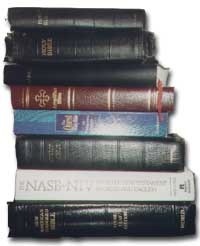
My Own Journey. I've been collecting English translations of the Bible for over two decades and now own a number approaching ninety different translations. Believe it or not, there are still quite a few in circulation that I still do not have (but I have a list!). Two of my most recent acquisitions include an original 1959 edition of Verkuyl's Berkeley Version of the BIble (the first edition with the Old Testament, and the precursor to the edition I reviewed) and the New Testament Transline which was sent to me by Wayne Leman. It may be the most literal modern translation I've seen so far.
Even after taking original language courses in seminary and working these texts into my study practices, I still publicly teach from English translations. I do this for two reasons. A common translation serves as a better common ground base between myself and those in my classes, although I can certainly supplement with my own translation as I need to. Further, my language skills are not good enough yet. I've tried it, and while I can certainly prepare for a focus text, as soon as a question is raised about another passage and we turn there, I run into a word I either do no know or can't remember, and so it's not yet practical for me to use the Greek and/or Hebrew exclusively.
Although I've always celebrated the variety of translations available, up until two or three years ago, I was squarely in the formal equivalent camp in regard to what I used as a primary translation both in public and in private. It was primarily the needs of my audience--the result of my experience teaching both high school students at a private school for about five years and my long term experience teaching adults at church--that made me change my translational tool belt around a good bit. Although I personally preferred more literal translations, especially the NASB, I was never the kind of person I occasionally run into who thought that dynamic/functional equivalence was an illegitimate method of translation. However, like a lot of people, I naively assumed that literalness was always equated with a greater degree of accuracy. However, it was in my experience teaching that I realized if a literal translation does not communicate the message of the original--if the readers or hearers cannot understand it because of its literalness--it is not more accurate; it is less so. I've tried to demonstrate this in a number of my posts with my favorite being "Grinding Another Man's Grain" (also see "This Is Why" and "Literal Is Not More Accurate If It's Unintelligible").
Since I began this series, my own practices have changed somewhat. When I began writing it, I was attempting to make the HCSB my primary translation in public and in private with the TNIV, NLT, and NASB in secondary roles. The HCSB and TNIV have switched places a good bit in much of my use over the last few months. In private I have gone back to taking notes in my wide-margin NASB because I haven't found a suitable replacement edition in any of the more modern translations that I use. This is too bad because I can't legitimately call any translation a primary one for myself until I can take the edition with which I've written my notes in private and teach from that same Bible in public. Nevertheless, when I am asked, I currently only recommend three translations for primary Bibles: the TNIV, NLT and the HCSB.
An Admitted Bias. I admit that I am biased toward newer translations for primary Bibles because they represent not only the latest scholarship, but usually the most current English--although certainly both factors are on a relative scale. That doesn't mean that the older translations are useless. I simply can't recommend them for anything other that secondary purposes--to be read in parallel with a primary translation or to be read for devotional use.
I freely admit that I cannot recommend something like the King James Version, as prominent as it is in Christian and literary history, as a primary Bible. I cannot recommend it for two reasons. The first is that it is based on a deficient textual tradition. This is where my bias for the most recent scholarship comes into play. And although I respect those who hold to a favorable tradition toward the Textus Receptus or the Majority Text, I would politely disagree. In my experience, most of those with whom I've come into contact who favor a TR position often are simply using it as an excuse to justify King James Onlyism. Otherwise, why wouldn't they use the New King James Version? This is certainly not always the case, but I find a lot of people who say they favor the TR, but claim the NKJV as corrupt and practically put the KJV on its own level of inerrancy. Really, I have little patience with this, and simply cannot take such positions seriously.
Secondly, I cannot recommend the KJV to the average church member simply because of my experience in teaching the Bible to adults over the last two decades. Over and over I've seen people struggle with the KJV, often failing to understand what they just read, and stumbling through the text when trying to read it aloud. In many cases I've given these people a modern translations and watched light bulbs go off over their head as suddenly the Bible has new relevance. And I don't know of a worse Bible to give to a child than the KJV. In the end, it simply comes down to a communication issue. I want to see God's Word communicated as clearly as possible
For those who appreciate the KJV on a historical and literary level, we have no argument. I agree that it's place is secure in those regards.
The Bible Wars. It genuinely saddens and even distresses me that adherents of modern translations would fight over which version is supposedly better. I am appalled at some of the rhetoric thrown around toward certain translations often as a smokescreen for promoting another version. Yes, there are certainly translations I recommend over others--I've admitted that. But one thing I've tried very hard to do on this blog is not to promote one version at the expense of another. I really do believe in reading the Bible in parallel. Bible versions are different simply because they often have different goals and purposes. I also acknowledge that certain translations simply connect and resonate with individuals. Sometimes it is a personality factor (and Bible translations have personalities of their own) and sometimes it is for other reasons.
There is some good news though. Sometime near the end of 2006, I set up Technorati and Google search RSS feeds on a number of particular translations. I especially targeted translations such as the TNIV and NLT which I thought had been unfairly attacked more than any other versions. On this blog I went on the offensive promoting these translations, and on the greater blogosphere, I went on the defensive defending them whenever I thought they were given unfair treatment. The good news is that I see fewer and fewer of these kinds of negative posts. When I first started looking for them, I saw multiple posts every week. Since they often made the same charges over and over again, I began compiling a file of my own arguments so that I wouldn't have to retype so much information every time. I can honestly say now that sometimes entire weeks go by, and I really don't find that much to address. It's certainly still out there, and I don't think a ceasefire has been called in the Bible wars, but maybe we've seen a lull in the fighting and things will continue to die down a bit.
It's really pointless in my opinion. I mean who would go into Baskin Robins and try to convince people only to get chocolate mint when there are 30 other flavors to choose from? However, most of the folks who do this kind of thing with Bibles honestly think they are correct in their arguments. They somehow think they are defending God's honor and God's Word. The nonsense about the TNIV removing the masculinity of the Bible is just that--nonsense. All modern translations have moved away in some degree from masculine universals. Even the ESV, the most conservative of the new translations, has made a number of changes in this regard from the RSV. In many instances "sons" has been changed to "children" and "a man" has been changed to "anyone." These changes are certainly legitimate, but I don't think it's fair to label the TNIV or the NLT as translations that remove masculinity when even the most conservative of the modern translations (and not just the ESV, but also the NASB95) have done the same thing to at least some extent.
Further, the most recent argument I hear being thrown around is that dynamic/functional equivalent translations violate the command in Rev 22:18-19 to not add to or take away. Such an assertion is problematic on multiple levels. First, the actual command really applies only to the original manuscripts (this is why I favor newer translations because they are based on the most up to date editions of our Greek and Hebrew texts that are the results of very strong convictions to represent the original words of the biblical writers as accurately as possible). But if someone is just counting by numbers, every translation adds or takes away words to communicate the message of the original. Further, to say that translations like the TNIV or NLT violate Rev 22:18-19 would also eliminate the first major translation of the Bible, the Septuagint. The Septuagint itself does not follow one strict model of translation, and the student of the LXX will discover that some portions are quite literal and others are quite dynamic, even paraphrased at times. Are we going to level restrictions that would even eliminate the translation that the apostles, New Testament writers, and Jesus himself used? I think not. Really, to make such a claim as this reveals little more than a lack of knowledge for translation and translation history, and it serves to simply scare the average church member and cause unnecessary mistrust of certain versions.
The Current State. There seems to be a Bible for everyone, doesn't there? In the end this should be something to celebrate because it allows God's Word to communicate to the largest number of people possible. But do we have too many? The claim is often made that English speakers have countless translations which come only at great effort and expense while there are still some language groups that do not have the Bible at all in their language. This may be true. Our culture seems to find a way to bring gluttony into everything, and so perhaps we do so as well with Bibles. But nevertheless they are here. We can't untranslate any of them. And the reality is, as demonstrated in the various categories of my Top Ten, most of them fulfill a particular kind of niche.
So are all the niches filled? The English language will continue to change and textual criticism will improve, so there will be a need for new translations in the future. But I cannot imagine the need for any new translations right now. Perhaps the Orthodox Study Bible (OSB) that I mentioned earlier this week is a legitimate exception. This will be the very first official translation of the Bible for English-speaking believers in the Orthodox Church, so that seems like a legitimate niche. But I really cannot imagine any other niche that needs to be filled. Anyone thinking of forming a new committee to create a brand NEW translation should really rethink that idea--in my opinion.
Speaking of niches and the OSB, I'm really surprised that we haven't seen more translations based on the above mentioned TR/MT texts that have been released in recent years. I find that holders to the Textus Receptus/Majority Text/Byzantine textform traditions to be very vocal about their convictions. But I'm surprised that I haven't seen more translations based on this. It is well known that the HCSB was originally based on Farstad & Hodges Majority Text edition back when Farstad was till alive (Lifeway, who bought the copyright moved it to the eclectic text after Farstad's death). The edition of the Majority Text released two decades ago by Farstad and Hodges seemed to be readily embraced by a number of adherents (or at least a very vocal number). But in my own collection of translations, I only count one Bible version based on it, and it was self-published by the translator--certainly not a significant project in the big scheme of things. The text edition in vogue right now for many of these folks seems to be Byzantine Textform produced in 2005 by Maurice Robinson and the late William Pierpont. Who knows if we will see a translation based on this edition sometime in the future, especially since Robinson commands a significant amount of influence at Southeastern Baptist Theological Seminary. Or maybe if the upcoming OSB isn't too sectarian, and if it could be released simply as a text edition, it might do it for these folks.
But one thing we definitely don't need is yet another modern language update to the King James Version. There are half a dozen or more of these already: some in print, some only available online. I'll say it again... I don't know why the NKJV isn't enough for these folks.
Regardless, your options are out there. No one has an excuse not to read the Bible because it's supposedly too hard to understand. Certainly, there are still concepts that require serious study, but from a contemporary language perspective, all bases seem to be covered right now.
Here on This Lamp we will continue to review Bible translations. If I've reviewed 10 I suppose I still have a few dozen more to go. I have a life goal to read through all these, too, but unless I receive a gift of longevity, I may not be able to accomplish that goal--especially at the rate they seem to be published.
My thanks goes to you readers who have interacted in the comments providing feedback and occasionally even offering a guest blog entry. Keep it coming; there's still lots to discuss.
Up next: Top Ten Bible Versions: The Complete Boxed Set
Orthodox Bible Coming in Feb 2008?
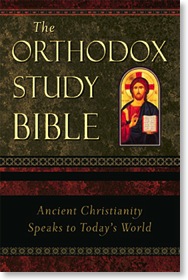
Theron himself worked on part of the OT project, specifically in translating segments of 1 & 2 Samuel, all the way back in 1999. The interesting twist (to me) is that at the time, Theron was a recent graduate of the Southern Baptist Theological Seminary (where he learned biblical Greek), but also a new convert to the Orthodox Church. Now that the OSB project is nearing its end Theron says he more excited about its release than the new Harry Potter novel.
I would hope so...
Making the Case (Yet Again) for Wide Margin Bibles
Although I've provided the link above, it won’t remain active after a few weeks, so I’ll include a screenshot below:
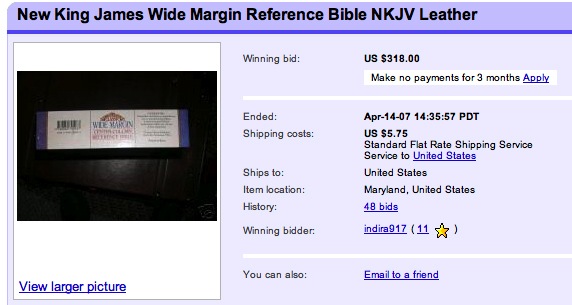
It boggles my mind really to think that someone would pay $318 for a wide margin NKJV--and a bonded leather one at that! But Larry summed it up quite well in his comments when he said this:
This must be proof positive that people are passionate about wide margin Bibles. More than $300 for a bonded leather cheapo Bible from Nelson? A NKJV?
And the fact that Nelson allowed this to go out of print while Crossway is publishing multiple note-taking Bibles may perhaps play some role in the NKJV's fall and the ESV's rise. (Certainly, there are other factors, but given the investment that publishers claim to make in new Bibles, why wouldn't they want to make their franchises available in every format that there is demand for?)
I think you put your finger on it a few months ago when you pointed out that while sales of wide margins may appear weak, they are sold to opinion makers -- and thus influence many more sales.
I've had representatives from three different Bible publishers tell me that wide margin Bibles just don't sell well. But it's that last statement made by Larry that I believe most Bible publishers just don't get. But Crossway gets it. They know that the teachers, preachers, and other serious Bible students want wide margin Bibles. And even if these particular buyers don't represent a large market, the fact is that this is the group that influences the purchases made by those sitting under their instruction. The fact that Crossway gets this is evidenced by the fact that they offer four different ESV Bibles with wide margins: The Deluxe Reference Bible, The Journaling Bible, The Single Column Reference Bible, and the Wide Margin Reference Bible.
But where are the decent wide-margin Bibles from the other 21st century translations (NLTse [2004], HCSB [2004], NET [2005], TNIV [2005])? Let's run through that list real quick.
New Living Translation
The original NLT1 (1996) had one of the best wide margin Bibles I've ever seen in terms of the Notemakers Bible. It had a healthy one and a half inches of space in the margins of a single-column text and two inches of lined space at the bottom for journaling. But since sells weren't that great, Tyndale has decided not to release an edition in the NLT second edition.
But why didn't the Notemakers Bible sell? The Living Bible and its inheritor, the New Living Translation have always been a bit of a populist Bible. While scholars put down the original Living Bible, Christians bought them in droves, and many testified that this was the first Bible they ever really understood. But these were probably not the kind of folks--for the most part--who would have been interested in a wide margin edition for their own notes.
The 1996 NLT wasn't that far removed from it's predecessor--especially in the public's eye--in spite now being called a translation rather than a paraphrase. Regardless, the top notch team of Evangelical scholars who produced the 1996 first edition reconvened to tighten up the translation, bringing it closer to the autographs and hopefully bring about the respect the NLT deserved. That resulted in the 2004 NLT second edition, which although quietly introduced was radically different than the first edition.
To gain even greater credibility, Tyndale has begun the Cornerstone Biblical Commentary Series, based solely on the NLTse. From the two volumes I have so far in the series, I can say that it's an excellent evangelical commentary series on the Bible. And I'm not sure it could have been based on the earlier NLT1 (let alone the Living Bible) without a great amount of work. But the NLTse is a different creature! And now that a commentary series is based on it, what would be a better match than an NLTse Bible with wide margins to study along with it and make notes? It seems to only make sense to me.
Holman Christian Standard Bible
There is only one wide margin HCSB Bible available: The HCSB Minister's Bible. So far it has received mixed reviews (see my review here). The main complaints stem from paper that is too thin and wide margins that really aren't that wide. Plus I've had more than one person email me who was not a minister saying they would like to use it simply to have a wide margin HCSB, but have been reluctant to do so because they feel funny carrying around something with that title on the spine. I'm really surprised there aren't more offerings here from Holman considering the HCSB is now the default translation in all of Lifeway's Sunday School curriculum. It would seem to me that a decent wide margin HCSB would be a perfect match.
NET Bible
I'm not totally surprised that the NET Bible has not seen a wide margin edition yet. Certainly with 60,000+ notes, one would wonder what could be added. Plus, the NET is still trying to gain the attention of the larger Evangelical world. Selling through more than merely mail order might help them out some. To me of all these Bible translations listed here that don't have wide-margin editions, the NET is the only one that gets a pass.
Today's New International Version
I would guess that the possibility of a TNIV Wide Margin Bible primarily suffers from the mixed track record of Zondervan's wide margin NIV and NASB Bibles. But if these editions have not sold quite as well as Zondervan would have liked there might be a reason why. Last year when I posted a Survey of Wide Margin Bibles by Version, I counted two other publishers of wide margins NIV's besides Zondervan and and three other NASB offerings. Could it be that the market for NIV and NASB wide margin Bibles is simply flooded? Consider also that most NASB aficionados have been using the classic single-column reference edition since the 1971 NASB. Foundation Press now offers a variety of high quality leather bindings in the classic reference edition, while Zondervan only offers hardback and bonded leather. There is a similar weakness for Zondervan's wide margin NIV: Cambridge offers a variety much higher quality bindings (scroll down to the bottom of the page for the previous link).
I'll come back to this, but one thing I believe that publishers like Cambridge and Crossway might get and Zondervan might not, is that people who buy a Bible for taking notes in want to use this Bible long term. Generally, there's going to be a preference for higher quality bindings. And if there's a choice, quality will trump cost--at least for these buyers.
The TNIV does have a wide margin represented in the "Squared" Bible. However, the TNIV Squared Bible breaks two cardinal rules of wide margin Bibles: (1) It is a thinline Bible, so the paper is not suitable for heavy annotations, and (2), as a two-column text, it does not allow any margin for the inner column. Ultimately, this Bible misses its intended market.
There is a TNIV Reference Bible coming out later this year, and many of the "gatekeepers" will use it as the best option of what's available, but I get emails and comments on this blog every week bemoaning the fact that it's not a wide-margin TNIV Bible. I would hope that eventually Zondervan will offer the TNIV Reference in a wide-margin offering.
Here's what most publishers are missing...
Most publishers don't get two things about wide margin Bibles:
- Despite lower sales, wide margin Bibles are for gatekeepers, and gatekeepers influence the translation choice of others who will buy the more popular editions.
- People who are in the market for a wide margin Bible want a quality Bible: genuine leather or better and a solid stitched binding. A wide-margin Bible is going to be considered by most to be a long term investment.
Finally, there's another little secret that Bible publishers don't realize, and I almost even hate to bring it up. But as evidenced by the sale of a $318 wide margin NKJV on eBay, people who want wide margin Bibles are willing to pay extra for them. It is well known that publishers make limited printings of some Bible editions. Why can't this be done for wide-margin Bibles, too? Heck, I imagine most of us would even be willing to order them straight from the publisher if there's some fear they wouldn't sell in stores. But most of us who would like to use a wide margin Bible would be willing to pay upwards of $100 knowing that it would be a long term investment, knowing that it should be a publication made with the utmost standards in binding and materials.
The wide margin survey that I posted last year remains one of the most popular pages on this blog. It gets hits everyday. There's a market out there. The products just need to match the demand.
Top Ten Bible Versions: The Honorable Mentions
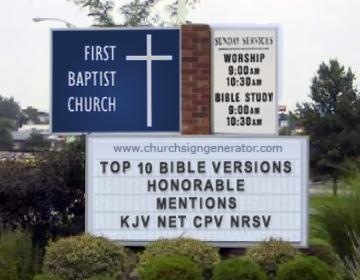
In hindsight, I don't know if the "Top Ten" designation was all that accurate because these aren't the ten Bibles I use the most. But in addition to the first few which I actually do use a good bit, I also wanted to introduce a few other translations that have stood out to me over the past couple of decades since I began collecting them. There are a few other Bibles that were contenders for such a list. I thought that I could briefly mention them in this follow up post.
King James Version.
I would imagine that if most people put together a top ten list, the KJV would be on it. I almost included it, but it seemed too predictable. Plus, I'm in no position to necessarily write anything new on the KJV (not that my other posts were wholly original either). Nevertheless, the KJV does deserve recognition because no other English translation has held the place of prominence that it has in the history of translations. It is still used today as a primary Bible by millions of Christians, still ranks somewhere in the top three positions of sales in CBA rankings, and even for those who have moved onto something newer, it is still the translation that verses have been memorized in like no other version.
I predict this is the last generation in which the KJV will still receive so much attention, but I have no trouble saying I may be wrong. It's difficult to say that one can be reasonably culturally literate--especially when it comes to the standards of American literature--without a familiarity of the KJV. Nevertheless, I cannot in good judgment recommend the KJV as a primary translation for study or proclamation because its use of language is too far removed from current usage. I don't mean that it's entirely unintelligible--not at all. But a primary Bible should communicate clear and understandable English in keeping with the spirit of the Koiné Greek that the New Testament was written in. I also cannot recommend it as a primary Bible because of the manuscript tradition upon which it rests. There's simply too much that has been added to the text. It was certainly the most accurate Bible in its day, but this is no longer true. My exception to this, however, is that I do find the KJV acceptable for public use with audiences made up primarily of senior citizens since this was exclusively their Bible. And the KJV still seems to be appropriate for use in formal ceremonies including churches and weddings--although I have not recently used it for such.
There is some confusion on what is actually the true King James version. Most do not realize that the average KJV picked up at the local book store is not the 1611 edition, but rather a 1769 fifth edition. And the reality is that there are numerous variations of this out there. For those who want a true and unadulterated KJV, the recently released New Cambridge Paragraph Edition seems to be the one worth getting.
The NET Bible.
The NET Bible is one of about four translations (including the ESV, NRSV, and KJV) of which I received the most emails asking why it wasn't included in my top ten. The primary initial reason for the NET Bible's exclusion was simply that I had not spent enough time with it. I made the unfortunate decision to purchase a "2nd beta edition" only a few weeks before the final first edition came out (of which I recently obtained a copy).
Everyone I've heard speak about the NET Bible has high remarks about the 60K+ notes that come with the standard edition. And I can honestly say that these notes have become a regular resource for me when I study a passage. I don't hear as much high praise for the translation itself, though I don't hear anything particularly negative about it either. In general, though, I do recommend the NET Bible. I really like the editions I've seen made available--not just the standard edition, but also the reader's edition, and the Greek/English diglot which I'm very impressed with. The notes in the diglot are a slightly different set than what is in the standard edition. The "ministry first" copyright policy and the ability to download the NET Bible for free from the internet are very commendable on the part of its handlers.
I'd like to see the NET Bible get more attention, and I'd like to see more people introduced to it. I'm not sure it will get the widespread attention it deserves as long as it can only be obtained through Bible.org. In spite of the fact that my top ten series is over, I am going to continue to review translations, and the NET Bible will probably receive my attention next. But we have to spend some quality time together first.
The Cotton Patch Version.
I decided not to include a colloquial translation in my top ten, but if I had, the Cotton Patch Version of the New Testament would have held the category. Most colloquial translations are fun, but a bit gimmicky. The Cotton Patch Version rendered from the Greek by Clarence Jordan was anything but gimmicky. During the height of the Civil Rights Movement in the 1960's, Jordan recast the events of the New Testament in the Southern United States. Replacing Jew and Gentile with "white" and "negro," and status quo Judaism with Southern Baptists (of which he was one), Jordan clearly brought the radical message of the New Testament into current contexts. The Cotton Patch Version is certainly fun reading if you are familiar with Bible Belt southern locales, but more importantly, the message is gripping as well.
The New Revised Standard Version.
The NRSV is an honorable mention I've added since I first announced the series. Originally, I felt like the NASB represented both the Tyndale tradition and formal equivalent translations well enough, plus at the time my use of the NRSV had become quite rare. Then my little NASB vs. NRSV comparison that I wrote with Larry revived my interest in the NRSV, and I now even have a copy sitting on my desk.
A year ago, I would have thought that the NRSV had seen its last day in the Bible version spotlight--except for academic use, but it seems to have had a bit of a renaissance with new attention and even new editions being published. It is still the translation of choice for the larger biblical academic community, primarily in my opinion because it has the widest selection of deutero-canonical books available of any translation. In its early days the NRSV was also embraced by many in the evangelical community but such enthusiasm seems to have waned. I think than rather than fears of theological bias, evangelical readers simply have too many other versions to choose from since the release of the NRSV.
Yes, the NRSV may be a few shades to the left of evangelical translations, but I've spent enough time with it to state clearly that it is not a liberal Bible. Don't let sponsorship from the National Counsel of Churches drive you away. If that were the only factor in its origin, I'd be skeptical, too, but the fact that Bruce Metzger was the editorial head of the translation committee gives me enough confidence to recommend it--if for nothing else, a translation to be read in parallel with others.
Well, is the series done? Not quite yet. I'll come back later this week with a few concluding thoughts about the list and the current state of Bible translations in general.
Habakkuk 1:12--You or We?
I've seen you talk about both the NASB and the TNIV, both of which Ihave and I like both of them a lot. In my dialogues with Jewishpeople, they have asked me about Habakkuk 1:12 and I know that it istranslated differently depending on which translation you read from.I was wondering why certain translations use the Masoretic textversion and others don't.
This is a good question, and frankly, a difference in versions that I'd never noticed. To demonstrate the difference, consider the two translations mentioned above:
NASB |
TNIV |
Are You not from everlasting, [no note] |
LORD, are you not from everlasting? *An ancient Hebrew scribal tradition; Masoretic Text we. |
The TNIV makes a break with the Masoretic Text ([MT] the Hebrew clearly says we as does the Septuagint [LXX]!). The question is, Who or what is this ancient scribal tradition? At the time I received this email, I was away from the library, and didn't have the resources to look at the issue in depth. Of course I always have Accordance with me, but I've purposefully chosen at this point not to purchase commentary modules, so I was strictly dependent upon whatever reference resources I could find. Regarding the issue in Hab 1:12, I found two mentions.
First, I found a reference to the you/we issue in Hab 1:12 in the Anchor Bible Dictionary, in the context of an article on "Euphemism and Dysphemism in the Bible" by Marvin H. Pope. Pope makes no reservation in regard to his feelings on the correct reading: "In Hab 1:12, the assurance to God “You will not die” was changed to the patently absurd “We will not die,” to avoid even the thought that God could die."
Another resource I had in Accordance was the NET Bible, which is quickly becoming a first stop resource in regard to textual issues. The note in the NET for this verse states,
The MT reads, “we will not die,” but an ancient scribal tradition has “you [i.e., God] will not die.” This is preferred as a more difficult reading that can explain the rise of the other variant. Later scribes who copied the manuscripts did not want to associate the idea of death with God in any way, so they softened the statement to refer to humanity.
Okay, so the reason behind the change begins to make sense. This becomes a similar issue to "curse" being changed to "bless" in Job 2:9 (the Hebrew of the MT says "bless" (barekh), but nearly all translations render the word "cursed" based on context and the assumption that the original reading was changed by scribes who didn't want to associate cursing with God in the scriptures).
But the question remained: Who is this ancient scribal source?
I consulted a handful of commentaries today, and the most succinct explanation comes from Ralph Smith in the Word Biblical Commentary:
lo’ namut "we shall not die" is one of eighteen passages in the OT called tiqqune soferim "corrections of the Scribes" by the Masoretes. The scribes were supposedly to have corrected the original reading. The original reading of this passage was probably lo’ tamut "you shall not die" referring to God. Even though there is no manuscript or version support for tamut it is probably the best reading.
A number of commentaries with discussions on this issue recommended these sources for further study:
- J. Weingreen, Introduction to Critical Study of the Hebrew Bible, 25-29
- E. Wurthwein, The Text of the Old Testament, 18-19
- C. D. Ginsburg, Introduction to the Massoretico-Critical Edition of the Hebrew Bible, 358
- E. R. Brotzman, Old Testament Textual Criticism, 117-118
There's another question here, though, isn't there? It's a canonical question. What exactly should be considered the final form? How significant is it that both the MT and the LXX agrees on the alteration to "we"? There are no manuscripts with "you" in the text for Hab 1:12. So, what forms the basis of the canon? Our English Old Testaments are primarily based on the MT, in spite of the fact that the NT writers quoted primarily from the LXX. Is the Canon based on the MT? Is it to be based on the LXX (the Orthodox Church takes this position). Is it the MT checked by the LXX and the Dead Sea Scrolls (DSS) and perhaps even other sources?
I believe it's the last option. And in defense of that, we should remember that modern New Testaments are based on what's called an eclectic text, that is a source that attempts to reproduce the oldest and best (i.e. original) readings, based on manuscript evidence and the methods of textual criticism, and in spite of the fact that no Greek manuscript will completely reproduce the exact same wording entirely. Nevertheless, our English Old Testaments tend to be based on the Masoretic Text, an AD 11th Century document (that's AD, not BC). I've said it before and I will say again: we need an eclectic Old Testament text to form the basis of our English translations.
Recent translations such as the NRSV, NLT, NET, HCSB, ESV, TNIV and others use the LXX and DSS to "correct" the MT in places. How long will it be before we see a true critical edition that incorporates these alternatives into the text?
For point of reference, here are how some other translations treat Hab 1:12:
“Are you not from everlasting,
O LORD my God, my Holy One?
We shall not die.
O LORD, you have ordained them as a judgment,
and you, O Rock, have established them for reproof.”
[no note] (ESV)
“Are You not from eternity, Yahweh my God?
My Holy One, You* will not die.
LORD, You appointed them to execute judgment;
my Rock, You destined them to punish us.”
*Alt Hb tradition reads we (HCSB)
“GOD, you’re from eternity, aren’t you?
Holy God, we aren’t going to die, are we?
GOD, you chose Babylonians for your judgment work?
Rock-Solid God, you gave them the job of discipline?”
[no note} (The Message)
“LORD, you have been active from ancient times;
my sovereign God, you are immortal.
LORD, you have made them your instrument of judgment.
Protector, you have appointed them as your instrument of punishment.”
[note already quoted] (NET)
“O LORD, are you not from everlasting?
My God, my Holy One, we will not die.
O LORD, you have appointed them to execute judgment;
O Rock, you have ordained them to punish.”
[no note] (NIV)
O LORD my God, my Holy One, you who are eternal—
surely you do not plan to wipe us out?
O LORD, our Rock, you have sent these Babylonians to correct us,
to punish us for our many sins.
[no note, but is this an attempt to incorporate both traditions?] (NLTse)
Are you not from of old,
O LORD my God, my Holy One?
You* shall not die.
O LORD, you have marked them for judgment;
and you, O Rock, have established them for punishment.
[*You — Ancient Heb tradition: MT We] (NRSV)
Lord, are you not from ancient times my God and Holy One, who is immortal?*
Lord, you have appointed them to execute judgement;
my Rock, you have commissioned them to punish.
[prob. original rdg; altered in Heb. to we shall not die. (REB)
Industry Insider: Bible Translation Rankings Are Faulty
Well despite the fact that we don't get the full picture, the reality of the system in place for CBA stores is even worse.
This morning, I received an email from an industry insider who asked to remain anonymous, but agreed to let me summarize/paraphrase the content of the email.
According to this person--who has been tracking Bible sales for four years--ECPA/STATS figures, which are reported by the CBA, has been having problems with their Bible market share numbers for quite some time. A number of publishers, including the "market leader," have complained for a while now that the numbers simply don't add up to their own calculations--something my emailer confirmed since this person has been tracking these numbers for some time, too.
And my emailer also told me that even if the numbers were correct, the rankings would still be deceptive because two of the Bible market's bestsellers, the Nelson Million Bible Challenge [$1] and the ESV Outreach NT [50¢] are sold primarily based on price and not translation choice. Bibles such as these serve to skew the rankings based on the way the current system works. Evidently, if these two products were eliminated from the stats OR if rankings were based in pure dollar sells, the top ten list would look quite different.
This same person told me that a better system of ranking is coming soon. Stay tuned because I'll let you know more about it as soon as I'm able.
May CBA Top Selling Bible Translation Lists Posted
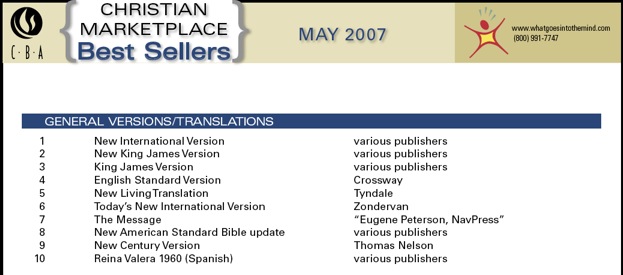
Of note: the NIV is back on top after a 3rd place showing below the KJV and NKJV last month. The ESV is now at #4, pushing the NLT down to #5. The TNIV is up to #6 from #10 last month. The HCSB remains nowhere to be seen for yet another month.
Bible Translation Awareness Survey Results

This was actually the third week I'd carried the survey with me as I was waiting for an ideal representation of our roll to respond. Yesterday we had 35 class members in attendance, no visitors, and about 10 of our regular attenders were absent. I handed out 35 surveys, but only got back 26. We are in a Southern Baptist church, and our class uses Southern Baptist curriculum.
Here is how I introduced the survey on the form I handed out to everyone:
Augustine said that it was profitable to study the Bible with parallel translations. On any given Sunday morning, there are multiple translations of the Bible represented in our Quest Bible Study—and that’s a good thing! This survey will help your teacher in his preparation by knowing what translations are in use in the class by what percentages of learners. Also, it will help him gauge your awareness of translations. Please answer the questions as honestly as possible.
Here are the results of the survey:
Q1. What translation of the Bible are you using this morning? [I had a list of translations to choose from including an option for other and an option for the Sunday School quarterly instead of a Bible]
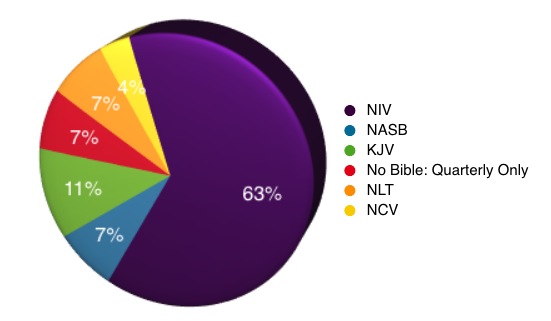
- 2 said they didn't bring a Bible, but were using a quarterly. This means they had access to the HCSB and KJV.
- 17 members were using the NIV. Our pastor preaches from the NIV, and of course, the NIV is the most popular translation in the US, so it no surprise that almost 2/3 of the class were using this version.
- 3 were using the KJV.
- 2 were using the NASB.
- 2 were using the NLT (I didn't specify which edition in the survey).
- We had one person respond saying he was using the NCV. I know of one other person in the class who uses the NCV, but he wasn't there today.
Q2. Did you know what translation you were using, or did you have to look at your Bible to double-check? [This was my awareness test. Assuming they answered truthfully, more folks are aware of their translation than what I would have imagined.]
Twenty-two answered "I knew"; three answered "I had to double-check."
Q3. What translation of the Bible does your teacher use? Don't guess. If you don't know, write, "I don't know."
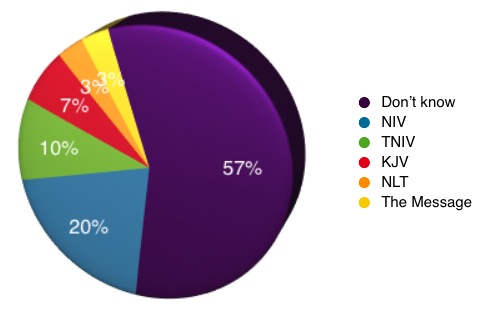
- 15 respondents said they didn't know what translation I was using.
- 6 said that I was using the NIV.
- 3 said I was using the TNIV.
- 2 guessed I was using the KJV!
- 1 suggested the NLT
- 1 thought I was using the Message.
The correct answer is that I use the TNIV. When we started the class last March with less than a dozen members, I was teaching from the HCSB because it is the primary translation in the Sunday School quarterly. However, last fall while teaching through Hebrews, I switched to the TNIV, so I've been using that for about six months. I did use the Message one time a few weeks ago to read through an extended passage in Esther. I mentioned that I was reading from that version, and that name must've stuck with someone. I have never and would never use the KJV to teach a regular Sunday School class. I've used the KJV occasionally in other venues, especially when speaking to senior adults.
I mention now and then that I am reading from the TNIV, but I don't make a big deal out of it.
Q4. When you study your Bible at home, do you ever use another translation? If so, list what you would consider your primary translation, and what you would consider any secondary translation(s). If you never study your Bible at home, simply write, “I never study my Bible at home” (this survey IS anonymous!).
One person admitted that no Bible study ever takes place at home. Here are the rest of the results:
Primary translations:
- NIV: 17
- NLT: 2
- KJV: 2
- NASB: 1
Secondary translations:
- KJV: 6
- NIV: 2
- NASB: 2
- HCSB 1
- NCV: 1
- NKJV: 1
- Amplified: 1
- Phillips NT: 1
Q5. If you lost your main Bible and had to buy a new one this week, would you buy the same translation you checked in question #1 or would you get a different one? If you would get a different one, what would it be?
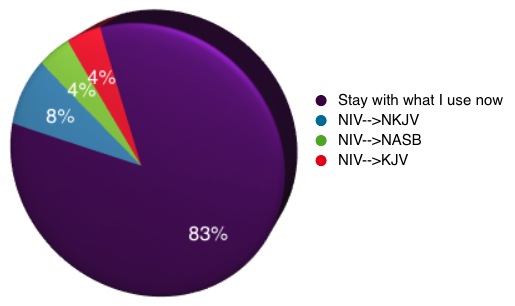
- 20 of those surveyed said that if they had to replace their Bibles, they would stick with the translation they currently use.
- Two said they would switch from the NIV to the NKJV.
- One indicated a switch from the NIV to the NASB.
- One said a switch from the NIV to KJV would take place.
Again, for anyone else, these results are simply anecdotal. But the majority of my class using the NIV reflects national trends. Further, if there're any broader implications to be drawn, question #5 would indicate that people don't change translations very often or very easily. Most importantly, my choice to teach from the TNIV is a good one with most of the class' members reading from the NIV. They can follow easily enough when I read from the TNIV as there is much continuity from their version, but at the same time the TNIV offers a more accurate and up-to-date option over the NIV.
One last thought... to my knowledge, there's been no recent class at our church about the history of English translations and the differences between them. I wonder if any of the questions would be answered differently if such a discussion took place prior to such a survey?
Link: Bible Translation Awareness Survey
Bible Translation Awareness (or lack thereof)
I'm not overly concerned with which particular translation a person uses as long as the interaction between the person and the version is meaningful. When occasionally asked what translation I recommend, my overarching recommendation is that a person reads a modern translation for a primary Bible. I never recommend the King James Version because in my two decades of teaching experience, the language and vocabulary--as beautiful as they are--is mostly not understandable by the person reading this Bible. I'm not opposed to the KJV, per se, and suggest it is fine to be read in parallel with a modern translation, but I believe it is past its use for the large majority of people in today's culture. Nevertheless, according to the April CBA bestsellers list, the KJV is ranked at #2 (under the NKJV), so a lot of folks are still buying it. Obviously, they haven't asked my opinion!
When I say a modern translation, I'm not trying to proclaim bias against the very beautiful and useful translations of the past. But the reality is that our language is changing, perhaps moreso right now than in the last hundred or more years. Further, and more importantly, I believe that modern translations have the benefit of textual criticism and ongoing linguistic research to create translations in English that more accurately reflect the message and intentions of the original biblical writers. I'm especially interested in how well 21st century versions (ESV [2001], The Message [2002], HCSB [2004], NLTse [2004], NET Bible [2005], and TNIV [2005]) render the biblical texts. Future posts will focus on these translations, and I'll probably include a couple of late 20th century versions which I believe still hold significant voices in the discussion, namely NRSV (1989) and the NASB update (1995).
Of course, while my main recommendation is for a modern translation, it's no secret to any reader of this blog that I have certain translations I favor. And when asked for particular recommendations in the last year or so, I've primarily recommended the NLT, TNIV, and HCSB. After elaborating on the differences between them, I've suggested that a person go to a local bookstore and read passages in all three. Of course, such a suggestion always opens the door to a sales clerk intruding into the process to push a favorite translation and dissuade the purchase of one that I may have recommended. If you don't believe this happens, go to a Christian bookstore and hang out in the Bible section for awhile. Play dumb about translations when the sales clerk comes over, and you'll often see an agenda in place for pushing a particular version.
All this leads me to bring up an article I received this morning in a Google News Alert of which I have a number of subscriptions pertaining to various Bible translations. This is yet another article in which the writer seems to be surprised that the Bible is still such a bestseller, outselling even Harry Potter (who would've thought it?!). But the context of this particular article is different because it relates to a vote that the Muscogee County (Georgia) Schoolboard will make on April 23 as to which translation of the Bible will be used in their new Bible-as-literature elective. Care to guess which translation the superintendent is recommending? The New KIng James Version (which happens to be #1 on the April CBA list). I've wondered over and over who is buying the New King James, a translation in general that I would only recommend to a diehard KJV-only adherent as a compromising alternative. Such a suggestion by the superintendent and much of the other information in the article itself suggest to me that I'm very much correct about the state of unawareness when it comes to Bible translations. Consider the following:
- In attempt to update the reader on other translations besides the KJV, the writer Allison Kennedy offers brief publication background on three "newer" translations: the NIV, NASB, and NKJV. Such a list would have been understandable if this article had been written in say, 1985, but there has been much significant progress made since these three translations. Of note, Kennedy doesn't even mention the 1995 update to the NASB which makes me wonder if she was using an older source for her information.
- From the article: "Joy Ahlman is a student of the Bible who takes her translations seriously. For years, the Christ Community Church member used the New International Version and the New Living Translation because both have clear language, but now she's recently switched to the New American Standard. 'I prefer to take time to study and it has cross-references and translations of different words at the bottom.'" Well, it will certainly take Joy more time to plow through the NASB than the NIV and NLT, but I'm more stunned at her reason for switching regarding "cross-references and translations of different words at the bottom." Such features are readily available in editions of the NIV and NLT, too. But such a statement demonstrates a common confusion between text and features in the minds of many Bible readers. Many times I've had to explain the difference to a church member between the text itself as the actual scripture as opposed to study notes and other features. And I've also had to explain that two editions of Bibles don't mean two different translations.
- And of course, KJV-only adherents weigh in for Kennedy's article: "'I teach and preach from the King James,' said Vann, pastor of The Rock Baptist Church in Cataula, Ga. 'The reason I do that is because newer translations leave out certain words or phrases. It's not that I'm a King-James-only guy, but it makes the people dive in deeper.' Last year, Vann led the church through a study comparing some of the translations. 'It blew their socks off,' he said of his members, many of whom weren't aware of the differences." Yeah, I bet. They're so concerned about things being taken out of their Bible, they don't realize they're buying into a textual tradition in which things have been added that the biblical writers never wrote. You'd think that there would be concern that goes both ways. A little bit of text critical knowledge would go a long way in such situations.
- Granted, this is a nitpick, but at one point Kennedy calls the New Living Translation the "New Living Bible" and says that it comes in many versions, although what she means is that it comes in many editions.
- Interestingly, in the entire article, there was no mention of the ESV or TNIV, which may say more for the awareness of these particular translations than anything about the writer of the article.
When I taught Bible at a private Christian school for five years, I allowed students to use any translation they wanted with the exception of the King James Version. Although I've mainly used the TNIV over the past year while teaching, I haven't pushed it as a translation. In over twenty years of teaching the Bible in various venues, I've always encouraged a variety of translation use, and I've only said anything to something about their translation on a very small handful of occasions. I've made a point not to put down any particular translation. And any concern has usually been in regard to use of the KJV in which I felt they consistently misunderstood what what they were reading. Sometimes, I merely offer a Bible as a gift without making a big deal about their use of the KJV such as recently when I gave a copy of the NLT to a member of the class I teach on Sunday mornings. He now carries it every Sunday and has told me that he feels like he can understand the Bible for the first time in his life.
My overriding concern is that people have a life-changing experience with God's Word. I never want a particular translation to get in the way of that possibility. What's translation awareness like in your circles? Is it is a big deal? Should it be addressed occasionally or should it be ignored? Feel free to post your thoughts in the comments.
March CBA Bible Rankings
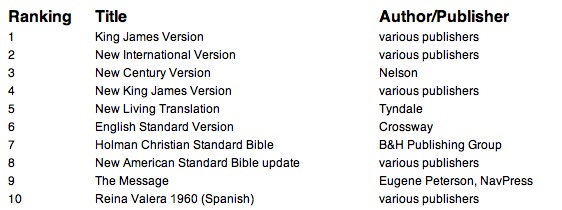
There are a number of interesting points to notice about this listing. First, if you've been keeping track, note that the TNIV has fallen off the list after its initial listing a couple of months ago. My suspicion that the TNIV's place was held primarily from the audio-based Bible Experience may be supported by my assumption that post-Christmas sales would see a significant decline.
Also note that the HCSB and the NASB have reappeared after falling off last month's charts. The HCSB had continually kept a spot on the chart around the halfway mark since its release in 2004, but then suddenly dropped off last month. The sale of the newly released HCSB Illustrated Study Bible (which appears on the Study Bible rankings for the first time) may have been part of the reason for the HCSB's renewed spot in the top ten. And the NASB had been on the chart for decades until it's drop last month, but now has claimed a spot somewhere around its usual position.
The chart suggests that the King James Version refuses to go away and has reclaimed the number one position, although it wouldn't surprise me if it goes back to #2 next month. What really surprises me is that the New Century Version would rank so high. Both the NCV and the NKJV are exclusively published by Thomas Nelson. I can't imagine the NCV attracting this kind of popularity, but it may say something for Nelson's marketing department.
What are your thoughts?
New to the Collection: Darby Bible
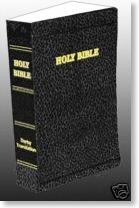
I've wanted a Darby Bible for a while because I knew it was a significant gap in the 19th century segment of my collection. Although I'm grateful to have a copy finally (and an inexpensive one at that), it's small size will prohibit any prolonged use of it by me. Fortunately, the text is available online in a number of places.
So are there any fans of the Darby Bible out there? If so, why do you like it?
Literal Is Not More Accurate If It's Unintelligible
One of the points that I had disagreed with Kevin on had to do with the claim often made by proponents of the ESV this their translation of choice is literal like the NASB but more readable. In my examination, I find this to be a highly exaggerated claim. My feeling toward the ESV is that it is weakened by its reliance on antiquated phrasings in the RSV (upon which it was based) and there's really no excuse that these have never been corrected. I often point to two representative verses as proof of my disbelief that the ESV is more readable than the NASB. One is Matt 7:1:
“Judge not, that you be not judged.” (ESV)
“Do not judge so that you will not be judged.” (NASB)
Try reading the ESV rending of Matt 7:1 out loud. The ESV employs an awkward use of a reverse negative ("Judge not"). The problem is that no one I know of speaks this way on a regular basis unless you want to count Yoda in the Star Wars movies (and he lived a long time ago in a galaxy far, far away). Even with the reputation that the NASB has for literalness and even woodenness, its translators had the sense to remove a great many of its uses of reverse negatives in its 1995 update (although some remain). Granted, you can find reverse negatives in just about any translation, but I would suggest that the ESV has more than any modern translation of the last 15 years or so because they were never removed when updating the RSV. This makes it less readable in these verses than the NASB and just about any other translation.
Another example I point to regarding the ESV's exaggerated claim of readability is a verse like Heb 13:2:
“Do not neglect to show hospitality to strangers, for thereby some have entertained angels unawares.” (ESV)
“Do not neglect to show hospitality to strangers, for by this some have entertained angels without knowing it.” (NASB)
Just because a word is in the dictionary does not make it standard English. The ESV's retention of the RSV's archaic and antiquated unawares is downright odd. I can't imagine anyone outside of perhaps a hillbilly community still using unawares today. These are merely two examples, but they represent a great many more. Yes, there are some places in which the ESV is more readable than the NASB, but the ESV is incredibly uneven because of its dependence on antiquated words and sentence structures in the RSV. My goal is not to knock the ESV so much as to challenge the outrageous claims of some of its proponents.
In response to the above two verses I suggested, Kevin said that the TNIV had flaws as well and gave Rom 1:3 as an example:
In Rom. 1:3, it changed it to "regarding his Son, who as to his earthly life was a descendant of David." In the ESV ... it uses "flesh." I think Paul wanted to use "flesh" to express the idea of "body." The TNIV might be a bit too loose in using "earthly life." It's only a possible intended meaning but not necessarily what Paul actually wanted to express in using "flesh."
While I do acknowledge that all translations have weaknesses, I personally don't see a problem with Rom 1:3 in the TNIV. The rendering "according to the flesh" [κατὰ σάρκα] in the ESV (and a number of other formal equivalent translations) while certainly reflecting a literal rendering, really doesn't communicate that much. Although there's part of me that likes a translation that renders σάρξ as "flesh" because it triggers in my mind the underlying Greek word, I know for a fact that for the average church-goer and for every non-church-goer, "according to the flesh" is a meaningless phrase. Most of my readers here know what "according to the flesh" means because they have the background for understanding it. But try to step outside your learning and think about the phrase from the ESV: "concerning his Son, who was descended from David according to the flesh." That is just unintelligible to those who don't have a knowledge as to what the phrase means because it reflects an idiom that is not in current English usage (especially outside the church). At best, use of "flesh" in this sense is insider church language, and I would still suggest that many sitting in an average Sunday School class couldn't give you an accurate explanation.
Obviously all Paul is saying is that Jesus was a descendent [υἱοῦ αὐτοῦ τοῦ γενομένου ἐκ σπέρματος] of David only in regard to his earthly body. He's being very careful not to imply that David actually came before Christ because in reality, Christ is eternal. Therefore, the TNIV's rendering "who as to his earthly life was a descendant of David" fully communicates Paul's intention. Yes, the ESV is more literal in the strictest sense, but in way similar to the point I was trying to prove in "Grinding Another Man's Grain," if literal is unintelligble, it is certainly not accurate.
Also note that the TNIV indeed has a footnote to this verse that says "Or who according to the flesh" which I feel is an INCREDIBLY responsible way to handle the verse. It gives a very readable rendering in the text and a literal rendering in the footnote. The best of both worlds, wouldn't you say?
Now on a related note, I've been mildly reflecting on Mark Driscoll's announcement that Mars Hill Church (Seattle, Washington) would replace the NIV with the ESV as their primary translation. Now on the face of things, that's perfectly fine with me. Every church should use the translation that best works in their context. They have a right and obligation to sort through such choices. My problem lies not with the choice, but with Driscoll's rhetoric as he elevates the ESV over translations he considers inferior.
As one of his reasons for choosing a new translation, Driscoll states "The ESV upholds the truth that Scripture is the very words of God, not just the thoughts of God." The context of the statement comes from two paragraphs earlier in which he writes, "we should transition from the NIV (more of a “thought-for-thought” translation) to the English Standard Version (ESV, more of a “word-for-word” translation) as our primary pulpit translation." In my opinion the statement made by Driscoll which I have highlighted in bold above betrays a lack of understanding of the differences between formal and dynamic equivalent translation methods.
However, this is case in point again to the fact that the ESV cannot stand up to the claims made by its proponents. Take for example Rom 1:3 discussed above. The ESV does not translate that verse literally throughout. In fact, it doesn't translate a significant Greek word found in the original text at all.
Rom 1:3, [περὶ τοῦ υἱοῦ αὐτοῦ τοῦ γενομένου ἐκ σπέρματος Δαυὶδ κατὰ σάρκα] in English literally reads "concerning his son who was born [γενομένου] from the seed [σπέρματος] of David according to the flesh."
Therefore, the ESV isn't entirely literal in this verse either. The ESV's rendering of "concerning his Son, who was descended from David" completely omits either γενομένου or σπέρματος. I would have suggested they are leaving out the former, but according to the ESV Reverse Interlinear, it's the latter. Regardless, if, as Driscoll says, the "ESV upholds the truth that Scripture is the very words of God, not just the thoughts of God," why then does the ESV offer a "thought-for-thought" (dynamic equivalent) translation for "γενομένου ἐκ σπέρματος Δαυὶδ" in Rom 1:3? Is the ESV shortchanging the word(s) of God? Is not every single word important? Is σπέρματος not inspired? According to Driscoll's own standards for why he chooses the ESV, the ESV itself cannot stand up. (Also compare with the NASB rendering of Rom 1:3 in which both Greek words are translated.)
Now, if you've read this blog for any amount of time at all, you'd know that I would have no problem with the ESV's rending of "concerning his Son, who was descended from David" any more than the TNIV's "who as to his earthly life was a descendant of David." Translation is more complex than simply looking up the definition of a Greek word and supplying an equivalent English word. Suggestion of such by Driscoll and others demonstrate a significant naiveté on the subject of translation method.
My contention is not with the ESV. But I do have great problems with the inaccurate rhetoric that I often hear from proponents and endorsers of this translation. I have favorite translations, and I have written about a number of them on this blog. While I talk of their qualities that I like and appropriate uses for them, I go out of my way to try to do so without needlessly putting down other versions of the Bible. I've probably been harder on the ESV on this blog than on any translation, but usually it's been in a context of addressing the audacious and often fallacious claims made for it by ESV supporters. This idea that literalness equals greater accuracy or literalness equals greater faithfulness to the original text is pure nonsense if the rendering is so literal that the author's intent and meaning is unintelligible to readers and hearers. Antiquated vocabulary and sentence structure do not give a translation greater authority--it merely limits readership in an contemporary setting.
The New Testament was written in Koiné Greek--the common trade language of the day--a language accessible by the masses. If a Bible version uses renderings that are not understandable to the masses, renderings that sound like they were written in any previous generation or written in some highly exalted form--regardless of how literally accurate--then that translation is not in keeping with the spirit or the manner in which the New Testament was written.
Jeshua or Joshua?
What makes this interesting is that most mainstream translations (KJV, NASB, NIV, REB, ESV, NRSV, HCSB, NLT etc.) render the name Jeshua instead of Joshua, and the Hebrew (יֵשׁ֡וּעַ) confirms this traditional rendering.
Then Jeshua son of Jozadak and his fellow priests and Zerubbabel son of Shealtiel and his associates began to build the altar of the God of Israel to sacrifice burnt offerings on it, in accordance with what is written in the Law of Moses the man of God. (Ezra 3:2 NIV)
Then Joshua son of Jozadak and his fellow priests and Zerubbabel son of Shealtiel and his associates began to build the altar of the God of Israel to sacrifice burnt offerings on it, in accordance with what is written in the Law of Moses the man of God. (Ezra 3:2 TNIV)
After a little digging on this priest with whom I was not overly familiar, I discovered that he is referred to elsewhere the Bible, specifically in Hag 1:1, 12; Zech 3:1-10; 6:11. And guess what? In each of these places, the same person is referred to as Joshua (יְהוֹשֻׁ֧עַ). How do we know it's the same person? Well, Jeshua/Joshua is almost always mentioned in connection with his father, Jehozadak the high priest. The real question might be why this person is referred to as Jeshua in Ezra and Nehemiah?
I did not come across any explanation in my reading as to why the name appears in the Hebrew differently, but I would welcome any insight. In the meantime, I could guess that Jeshua was probably simply a shortened form of Joshua, which is technically Yehoshua. Perhaps this is something similar to my name, Richard, being shortened by most who speak to me as simply Rick. But would the average English reader know that Jeshua is related to Joshua any more than someone from Japan might know that Rick is related to Richard?
The TNIV uses the more standard name Joshua and in doing so helps the reader form easier connections to other references to this person in the Old Testament. Is this a valid rendering for a translation committee to make? I believe so because it helps bridge the cultural and language gap between the Hebrew and English and communicates the meaning of the biblical text quite clearly. If that still bothers you--if you feel that the TNIV does not accurately translate the text in Ezra regarding the name of the priest, Jeshua/Joshua--keep in mind that if we really want to get picky, our translations would have to read Yeshua in Ezra and Yehoshua in the Haggai and Zechariah. The names in our English Bibles have been Anglicized--and quite a bit at that.
One more thing... although I have not done a wide survey of translations regarding the rendering of the name in Ezra, I found two other translations that streamline the name simply into Joshua: the Good News Translation and the Contemporary English Version.
And one final thing: the Anchor Bible Dictionary has a very good (but understandably brief) article on this priest who returned to Jerusalem from Babylon... but be sure to look him up under Jeshua.
Momentum Growing for TNIV
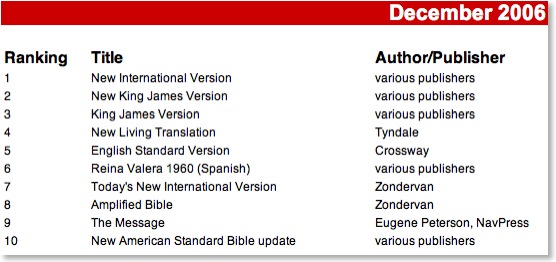
For those keeping track of translations released since the beginning of the new millennium, two points are with noting. First, the Holman Christian Standard Bible (HCSB), another translation recommended by this blog, has completely dropped out of the top ten list for the first time since it entered the rankings in 2004. Second, strictly for sake of comparison, the English Standard Version (ESV), now ranked #5, took about three and a half years to crack the top ten compared with less than two years for the TNIV. It may also be worth noting that the New American Standard Bible (NASB) now has one of the lowest rankings I can remember seeing.
The CBA rankings, while significant, do not paint the entire picture of Bibles sold. They do not include non-member stores, including large retail chains and Amazon.com. The CBA rankings are probably best described as Bibles that a large number of evangelicals purchase in actual stores.
Congratulations to Zondervan, the International Bible Society and the TNIV Committee on Bible Translation for the new ranking that demonstrates the growing acceptance of this very accurate and readable translation.
This Is Why
I'll admit that at least as far as five or six years ago from my own study, I realized that the NASB, while technically literal, was somewhat lacking in some places--especially in Old Testament poetic sections--when it came to bridging the language gap between the biblical culture and context and ours. Literal translations have difficulty communicating metaphors and symbolic imagery. It's easy for the meaning to become lost. But I continued teaching from the NASB nonetheless. Then my confidence in the NASB was completely shattered in early 2005 when in the middle of a half-year study on Romans I was teaching at my church, I realized that the translation itself was getting in the way. This was a study separate from any curriculum. It was all me. The problem arose, however, when I found I was having to explain the English of the NASB in order to explain the meaning of the biblical text. That was clearly an unnecessary step. Communication was impeded by the translation itself. Did that make sense? Translations are supposed to be bridges, but what if the bridges themselves are in disrepair?
I knew that there were two primary philosophies of translation: formal equivalent (word-for-word) and dynamic equivalent (thought-for-thought or meaning-driven). At the very least I knew that I needed to move a bit further down the spectrum toward dynamic equivalence. But how far? After spending weeks considering various translations, I settled on the Holman Christian Standard Bible for my Sunday morning translation of choice. It was a good bridge as a translation between the two methods because it was literal when it could be literal, but dynamic when that didn't work quite as well. Plus, our Sunday School literature uses HCSB. So I was teaching from the translation used in my class' quarterly.
And now we're in Hebrews. And I'm using curriculum this time. But sometimes I don't like certain turns the curriculum makes. Today's frustration came from the curriculum writer's decision to leave out nearly half of the verses in ch. 7. Hebrews itself is a complicated book in my opinion which may explain why very few ever touch it outside of the eleventh chapter. In my understanding, the writer is developing a carefully crafted, but complicated argument of why Jesus is better than the angels, the prophets, Moses, the High Priest, the Levitical priesthood, etc., and there's no possible way to go back to an earlier form of faith pre-Messiah.. I suppose that the curriculum writer chose to simplify things for the readers by leaving out a large section of the chapter. But in my opinion, he short-circuited the biblical author's argument in the process.
So I saw my task this morning as one of making my class understand the writer of Hebrews' argument--without leaving out any verses--and in the end creating room for some kind of practical application they could leave with. It's easy to get bogged down in Hebrews and forget that last part. I wrote in this blog a few weeks back that the KJV rendering of Hebrews seems unintelligible in places. I believe this is probably due to the difficulty of the Greek. And while the HCSB was good, and certainly better than the KJV or even the NASB would have been, I was still having some doubts, even as late as this morning about whether I was using a translation that made Heb 7 crystal clear. Somehow between the translation, my teaching ability, and the power of God's Holy Spirit, I wanted my class to have a clear understanding of Hebrews ch. 7 by the time they left the study. And so at the last minute--right around 8:30, a half hour before we had to be at church--I switched translations. I grabbed my TNIV, a translation that I although I have promoted on this blog, I have only used in public for devotional purposes.
Don't tell my pastor, but in the middle of his sermon on Romans 6, I stole over to Hebrews 7 and familiarized myself with the TNIV text. I had looked at it during my preparation, but I had not originally been planning to teach from it. Then when we got to our class after the sermon I began walking my class (the best metaphor for it) through the end of Hebrews 6 and into the seventh chapter. The fact that I was using the TNIV didn't really become a factor until the end when I read the last passage of our study, Heb 7:20-28, myself because we were short on time. Now, it was probably because of momentum built from our journey through the text thus far (I believe they were understanding), but as I read from the TNIV, I felt like they were extremely engaged and fully understanding the words--which in the latter part of ch. 7 do serve as a powerful summation and application of the writer's arguments.
I actually heard amens and other verbal affirmations while I was merely reading the biblical text (with enthusiasm, mind you). There was an excitement in the room simply as I read the Scripture passage. Amazing--I don't know if I've ever had so many people in tune before with what was being read from the Bible, with only minimal comment from me. Now, while there are quite a few factors involved, I have to think that the translation itself--the TNIV--was a primary contribution to my class' understanding of Hebrews today.“And it was not without an oath! Others became priests without any oath, but he became a priest with an oath when God said to him:
“The Lord has sworn
and will not change his mind:
‘You are a priest forever.’”
Because of this oath, Jesus has become the guarantor of a better covenant.
Now there have been many of those priests, since death prevented them from continuing in office; but because Jesus lives forever, he has a permanent priesthood. Therefore he is able to save completely those who come to God through him, because he always lives to intercede for them.
Such a high priest truly meets our need—one who is holy, blameless, pure, set apart from sinners, exalted above the heavens. Unlike the other high priests, he does not need to offer sacrifices day after day, first for his own sins, and then for the sins of the people. He sacrificed for their sins once for all when he offered himself. For the law appoints as high priests men in all their weakness; but the oath, which came after the law, appointed the Son, who has been made perfect forever.”
(Heb 7:20-28, TNIV)
And I didn't plan to write about any of this, although it's been on my mind and heart all day. Then I read Richard Rhodes' post tonight on Better Bible Blogs, titled "What's the Joke?" In this wonderful blog entry, he skillfully demonstrates why literal word-for-word translation is not always the best means for communicating meaning from one culture to another. He does this merely by trying to translate a newspaper cartoon from German to English. The entire article is well worth your time and demonstrates succinctly what's taken me a few years to learn through my experience teaching: literalness ≠ good translation.
Again, please read his entire post, but I must at least repeat his final thoughts here:
Our long use of translations that only approximate the meaning of the Greek (or Hebrew) has dulled our senses. It’s only in live cross-linguistic situations that we are confronted with the fact that language is regularly used with a precision we fail to appreciate from the inside. And it’s that precision that gets washed away in most Bible translations by our preference for literalness. Ironically, that preference all but guarantees that we will get it wrong.
If I think I'm teaching God's Word, but my students can't understand me, ultimately it's my fault. I have not actually taught; I've merely performed, and I've performed poorly at that. A Bible translation is like a tool. Certain jobs demand different tools, and some tools are right for the job while others aren't. I still recommend students of the Bible study in parallel with both formal and dynamic translations. But perhaps, for me, it's again time to go a little bit further down that translation spectrum regarding the
What Bibles Are People Really Buying?
Here's what I now know thanks to a knowledgeable, but (for your purposes) unnamed source:
• Contrary to my speculation below, CBA stores as a whole do indeed outsell Amazon by a healthy margin (I just thought everyone bought from Amazon like me).
• Bibles with the apocrypha sell better on Amazon because they can't be as easily bought in physical stores, especially CBA stores.
• Contrary to one of my conclusions below, the NRSV is not quite as healthy as perhaps I thought after initially looking at Amazon's results. Evidently, it is just easier to obtain through Amazon than other sources. Unfortunately, many editions of the NRSV have gone out of print and its use as a translation is on the decline.
• I was at least correct on one count--study Bibles do indeed outsell text Bibles. Surely this is a change in practice from a generation ago.
I could easily just remove this post, but regardless of the error in some of my conclusions and speculations, the information by itself is still fairly interesting. Plus, I don't mind admitting when I err.
Therefore, I am leaving the post as is. Enjoy.
There are five separate Bible bestseller lists in this blog entry. Only the last one may have any real significance.
What BIbles are people buying these days? This is a difficult question to answer because as far as I know Bible publishers don't report their sales figures to one central source that keeps track of such things.
Zondervan may be the only Bible publisher I know to release it's own list of top-selling Bibles. Here's the list as it stands today:
Zondervan Top Sellers
1. NIV Life Application Study Bible
2. NIV Audio Bible Dramatized CD
3. NIV Study Bible
4. NIV Teen Study Bible
5. NIV Adventure Bible, Revised
6. NIV Student Bible
7. TNIV True Identity
8. TNIV Pocket Bible
9. NIV/The Message® Parallel Bible
10. NIV Thinline Reference Bible
Zondervan's list is interesting, but we still don't know how its sales compare with other Bible publishers.
There's always the CBA bestseller lists, but as I've suggested before, these figures aren't overly representative of all BIbles sold. They leave out secular stores like Borders and Barnes & Noble. They leave out a number of Catholic and Jewish sources. And certainly, the most significant numbers that are left out are those of Amazon.com. The CBA numbers end up looking surprisingly Evangelical because they don't really adequately measure non-Evangelical sources which for the most part are non CBA stores.
Look for example at some of the CBA's recent best sellers for August (which actually means for July):
Specialty Bibles (whatever that is)
1. Cornerstone Reference Bible (KJV)
2. NIV Thinline Bible (NIV)
3. Spanish Reina Valera 1960 Outreach Edition (RVR)
4. Men's Devotional Bible (NIV)
5. Women's Devotional Bible (NIV)
Study Bibles
1. The NIV Study Bible (NIV)
2. Life Application Study Bible (NIV)
3. Archaeological Study Bible (NIV)
4. KJV Study Bible (supersaver ed.) (KJV)
5. Life Application Study Bible (KJV)
Young Adult/Children's Bibles
1. The Adventure Bible (NIV)
2. The Student Bible (NIV)
3. The Teen Study Bible (NIV)
4. True Images (NIV)
5. The Adventure Bible for Young Readers (NIrV)
Okay, I wanted to list these above for sake of contrast with another source for determining bestselling Bibles: Amazon.com. I really wish I knew how Amazon's sales numbers compare with those of the CBA. My guess (and it's only a guess) is that Amazon by itself sells more Bibles than all CBA stores combined, but I have no way of proving that--it's just a hunch.
Here's what I did. At Amazon.com's home page, I did a simple search for "Bible." Once the results were shown, I narrowed my selection by clicking on "Books" on the left. Then I narrowed my results further by clicking on the "Religion and Spirituality" link. Finally, I narrowed them one step further by clicking on the link that said "Bibles and Other Sacred Texts" (I could have narrowed one category further by clicking on "Bible," but I didn't want to eliminate the category "Torah"). The very last step is to change the "Sort by" drop down to "Bestselling."
Now I had my results. Although there were still quite a few non-Bible hits, it didn't take much effort to wade through to see what Bibles people were actually buying off of Amazon.com. The results may surprise you. I was certainly surprised by some of them.
AMAZON.COM'S CURRENT TOP SELLING BIBLES
1. The New Oxford Annotated Bible, NRSV with the Apocrypha, Third Edition (ISBN 019528478X)
2. The Catholic Youth Bible, NAB (ISBN: 088489794X)
3. The Archaeological Study Bible, NIV (ISBN: 031092605X)
4. Fireside Catholic Bibles: School and Church Edition, NAB (ISBN: 1556654901)
5. The Harper Collins Study Bible, NRSV with Apocrypha (ISBN: 0060655275)
6. The Message Remix (ISBN: 1576834344)
7. The New Interpreter's Study Bible, NRSV with Apocrypha (ISBN: 0687278325)
8. The Jewish Study Bible featuring the JPS TANAKH Translation (ISBN 0195297512)
9. Life Application Study Bible, NIV (ISBN: 0842348921)
10. Zondervan NIV Study Bible, Personal Size (ISBN: 0310923077)
In my opinion, the above list may be a more accurate list than anything else out there. Further, it's a very fluid list and could change at any moment as people make actual purchases. There are a number of interesting observations I could make about the above list.
First, note the stark predominance of study Bibles over text Bibles. The Message/Remix is a text Bible, and I'm not certain about the Fireside Catholic Bible, although I would presume the latter would include the NAB notes.
Second in spite of reports to the contrary, and in confirmation with my own findings when I posted on top blogged translations, the NRSV is far from dead. In fact, it's very well alive. Three of the top 10 are NRSV and if I had gone further, to the top 20, there would be even more listed including the Renovaré Spiritual Formations Bible.
Third, although the Jewish population makes up less than 5% of the population, I was very intrigued to see The Jewish Study BIble come in at #8, ahead of both the NIV Application Study Bible and the NIV Study Bible. If you're curious, the BHS came in at #13. Don't let anyone tell you that Judaism is not alive in well when it comes to study of the Scriptures.
Fourth, despite the fact that all of these Bibles will find some use outside their target audience, the selection essentially breaks down to 40% Evangelical and 60% non-Evangelical. Don't let anyone tell you that only Evangelicals are reading their Bibles. Here's a different way of looking at it: NRSV 30%, NIV 30%, NAB 20%, The Message 10%, and JPS 10%.
Sixth, 50% of the Bibles above include the Apocrypha. Evidently the debate over the limits of the Canon are not quite yet over.
Seventh, notice the absence of a number of newer translations including the NLT, ESV, HCSB, and TNIV.
Finally, just because something is on a bestseller list, doesn't mean that it's a quality selection. Look at any of the books on today's fiction or nonfiction bestsellers list and that becomes evident. However, if I had begun to list what I thought was a "popular" representation of Bibles being sold today, my list would have looked very different from the one above. Certainly, someone might say, "Well just because people are buying Bibles, doesn't mean they are reading them." Well, that's true. But if people were just buying Bibles to have in their homes or to carry to church and not really to read, I would have expected a lot of thinline Bibles and pocket and purse Bibles. With minor exception, the Bibles listed above are meant for serious study.
Surprising indeed.
Top Blogged Bibles
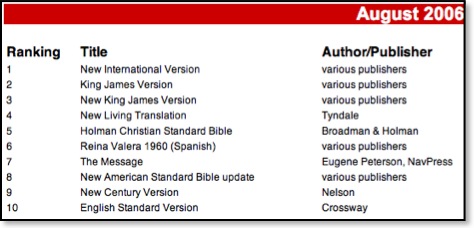
There are problems with these rankings, though. First, these sales probably do not adequately take into account Catholic Bibles sold in many stores that are not CBA members. Secondly, these rankings do not take into account sales of Bibles through non-religious stores in general such as Barnes & Noble, Wal-Mart, or even an online company like Amazon.com. I'm sure that if we could factor in sales from the large chains and a supplier like Amazon, the list might be significantly different. Too bad we can't see a ranking based on shipped items from each of the various Bible publishers instead of what's selling in a select number of stores.
Plus, a bought Bible is not necessarily a read Bible. To me, what's more interesting than the list of Bibles sold above might be a near-impossible-to-find list of Bibles that are used. As I was thinking about this, I wondered if we could get a listing of Bibles mentioned on the internet, specifically in blogs. So I did some searches for version abbreviations on Technorati and the results are very interesting.
A few notes before I show you the list. First, there was no reasonable way to determine the use of Eugene Peterson's the Message on the Internet because there's no standard abbreviation and the simple phrase "the message" might refer to many things beyond the Bible paraphrase. Similarly, there's no real way to search for the New American Bible because "nab" is also a word. Second, for similar reasons, I'm not including an searches for anything other than English translations. And third, a blog such as this one refers to many different translations, so none of these figures represent exclusive use of a translation. But even if I use the ESV for comparison's sake as opposed to a primary Bible, I'm still using that translation and such use bears some significance. Fourth, this survey does not include Bible references made in which no translation reference is made at all, and I assume there are a large number of these. Fifth, all of these numbers are inflated to some degree because these same abbreviations that I'm searching for are used in some blogs for other things. This issue was so significant, for instance, when I searched for "JPS" and "REB" that I chose not to include the results at all. In other words, these are not not scientific or exact measurements, but they are interesting measurements.
In the list below, I am listing translations in ranked order from highest to lowest. I am also including the "Mentions by Day" chart from Technorati for sake of comparison.
1. NIV: 74,723 hits

2. KJV: 29, 466 hits
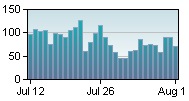
3. ESV: 19,174 hits
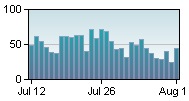
4. NLT: 19,122 hits

5. RSV: 13,351 hits

6. NASB: 11,422 hits + 823 hits for the incorrectly designated "NASV" + 146 hits for NASB95= 12,391
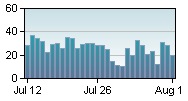
7. NKJV: 11,906 hits

8. NRSV: 5,877 hits

9. TNIV: 2,855 hits
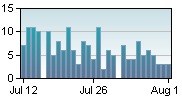
10. NCV: 2764 hits

11. HCSB: 1,206 hits + 81 hits for "Holman CSB" = 1,287 hits
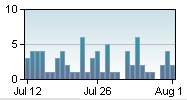
12. NJB: 827 hits
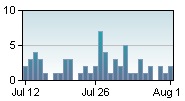
A number of observations:
• The top two spots belonging to the NIV and KJV aren't surprising, but what is surprising is how the NIV dwarfs all the other translations by comparison. It has almost two and a half more hits than the closest runner-up, the KJV; and it accounts for 40% of all hits combined. The number is so high that I went back after compiling all the numbers and ran the search for "niv" again so that I could take a closer look at the results. I wondered if "niv" wasn't a common abbreviation for something else. But a cursory glance revealed that most of the references were to the Bible and that the numbers for the NIV didn't seem any more inflated than the other numbers.
• Note that the ESV is #3 for blog usage compared with #10 for CBA sales. It even beats out the NLT, though not by much.
• Note the significant number of hits for the RSV and NRSV even though neither show up on CBA sales charts at all. The RSV may be a bit more inflated because evidently there's also a RSV virus to which some of the entries were in reference.
• Although the HCSB is ranked #5 on the CBA chart, it's near the very very bottom of the Technorati search. Maybe lots of people are buying HCSB Bibles, but they sure aren't blogging about it. Even the TNIV has more than twice as many hits as the HCSB.
These are just some initial thoughts. What do you notice in looking at the numbers? Leave your thoughts in the comments.
A Survey of Wide-Margin Bibles By Version
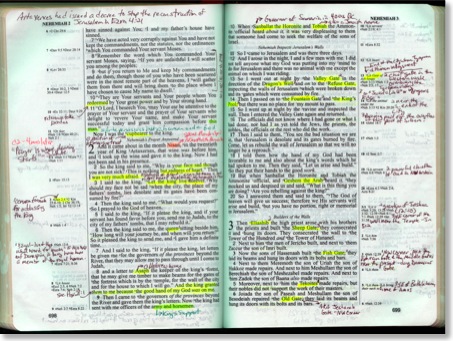
Above: a two-page spread from my NASB Side Column Reference Bible from Foundation Press. Pardon the messy handwriting.
I've always made the suggestion to my students to read the Bible daily, and study the Bible one to two times a week. To me there's a difference between the two. Perhaps in a future blog entry, I'll give greater delineation, but for right now let me suggest that real study of the Bible will include taking notes, and for me, I enjoy writing the most significant information directly into my Bible. I find my own habits humorous, but difficult to break. Perhaps it goes back to that overly exalted view of the physical Bible, but I find myself writing in my Greek New Testament only with a pencil. Usually these marks are of a textual or grammatical nature. Or sometimes I write in an English gloss for a very obscure Greek word. However, in my wide-margin NASB, I write in a multitude of ink colors and dry highlighters (I'll have to soon blog separately about my marking system, too). The notes in my English translation range from background information, underlying Greek or Hebrew wording, commentary, my own thoughts and reflections and profound quotations picked up here or there that seem to go with the text. Perhaps I'm more conservative to the Greek text because it's nearer in my mind to those actual autographs. I don't know, but my system is working for me.
My current habit is to study a passage of Scripture making the appropriate notes in my Greek New Testament and a wide-margin NASB from Foundation Publications. I prefer a more formal, literal translation for my notes, but I'm not saying that you have to do the same. I have a second wide-margin that I'm also using these days. Since our Sunday School literature uses the Holman Christian Standard Bible (and because I really like this translation), I have a copy of the HCSB Minister's Bible that I take with me on Sunday mornings to church. Since it's margins are smaller, and because I don't need everything I've noted anyway, I copy a subset of notes into my HCSB. Again, this is a system that is working for me.
I know that for some, it's very hard to start writing in the margins of your Bible if you grew up with the same mindset that I did. But I can testify to you, that I've never once accidentally mistaken one of my notes, written in the margin, as actual Scripture. And if you saw my handwriting, you'd agree that there's no chance of making that kind of mistake. I encourage everyone to make a habit of taking notes in your BIble. You will be amazed at how your Bible study is enhanced and how much those notes will come in handy at a near or later date. For even more encouragement on this subject, I would direct you to a blog entry by J. Mark Bertrand, entitled "Marginal Interest: Why You Need a Wide-Margin Bible."
In light of my encouragement to you to use a wide-margin Bible for personal study (in the translation of your choice), I have made a search on the internet for available wide-margin editions and grouped them according to translation (listed alphabetically). Below, I've tried to comment on these Bibles giving you the positive and negatives. I am not going to comment on extra features in a particular Bible such as the minister's helps in the HCSB Minister's Bible as that is not relevant to this blog entry topic. I have examined most of these Bibles by hand and I personally own two of them. Rather than linking to a particular outlet like Amazon.com, I am instead giving you the ISBN for each particular publication. All you need to do to find a supplier is to search for an individual ISBN in Google or your preferred search engine. You can also take these ISBNs and search for them directly on a site like Amazon.com or Christianbook.com or even give the number to a local merchant for ordering.
English Standard Version (ESV)
I'll hand it to Crossway for coming up with a number of really nice bindings that combine a traditional look and feel with quality materials. There are essentially two ESV Bibles with wide-margins.
Deluxe Reference Edition
These Bibles feature a traditional two-column text with a center column reference. Margins for taking notes are slightly less than one inch. The premium calfskin edition is one of the nicest (but also most expensive) ESV Bibles money can buy. Nitpicks: Top and bottom margins are not wide and therefore not suitable for much note-taking. Also the inner margins will not give you as much room for notes simply because of the binding itself.
Hardcover: 1581344368
Bonded Leather: 1581344384
Premium Calfskin: 1581343507
Journaling Bible
This edition of the ESV Bible is a fairly new release from Crossway and has received lots of attention. I really like the concept of this Bible, but I have a number of problems with the final product. Regardless, there's a lot to like here. The ESV Journaling Bible looks like something out of the Moleskine Catalog. It's hand-sized as a change of pace from many wide margin Bible and has a generous two inches of note space at the edges of the page. It has a two-column layout with center-column cross references. The paper is off-white, giving it an antique look in keeping with its moleskine design. The outer cover of the less-expensive edition (I haven't handled the calfskin leather one) is a padded hardback with an elastic strap (again in moleskine fashion) to keep it closed when not in use. I initially read in one review on the internet that it opens flat, even at Genesis 1, and while in a bookstore recently I confirmed that to be true. The price is also right for this Bible. I've seen it as low as $17.99 at a couple of websites. Nitpicks: I haven't heard anyone say a positive word about the size of the print. It's a tiny 7.5 type, the size in your average compact Bible. This is way too small to be useful as a note-taking Bible in my opinion, in spite of my attraction to the compact size. I think you just can't easily have both. Also, while I generally prefer a one-column text layout over two columns, if there are two columns in a Bible designed to take notes, it's imperative to have space next to the inner column. Otherwise, it's hard to designate notes for the inner column. And this is just me, but I would prefer no ruled lines since I often bracket verses and even write vertical headings. Perhaps Crossway is making a distinction between a Bible to journal one's thoughts in as opposed to a Bible to write notes in. I don't know. Regardless, as I said, I really like the concept of this Bible, but until another edition comes out that addresses some of the above concerns, I would have to recommend the Deluxe Reference Edition as a note-taking Bible to the person partial to the ESV.
Original (Elastic Strap): 158134838X
Calfskin Leather: 1581348398
Holman Christian Standard Bible
To my knowledge, there is currently only one wide-margin HCSB Bible available as of this writing, but I would hope that there will be more coming as this translation is still fairly new.
Holman CSB Minister's Bible
The HCSB Minister's Bible has a nice single-column text that is at a decent 9.5 pt. typeface in a text layout that feels neither crowded or rushed. The one-inch margins are at the outer edge, top and bottom of the page, but not in the center of the spread. The text has only black typeface (which I prefer), and the quality of the leather is good with raised ribs on the spine adding a nice touch. This is the Bible I teach out of on Sunday mornings. Nitpicks: The paper in this Bible is too thin. In an attempt to create a Bible suitable for taking into the pulpit, B&H made this Bible a quasi-thinline by using thinner paper. When you write on a page, the paper will curl. Closing the Bible for a while corrects this curling, but it can be annoying while you are using it. Personally I believe the sweet spot for a wide margin Bible is one and a half inches, not one inch alone. In poetic and prophetic sections, there is ample room for notes. But in prose sections such as the gospels or the epistles, there really isn't adequate room to write extensive notes. I can't imagine a pastor trying to copy his outline in these margins. Also, for the person who does not consider himself (or herself, as the case may be) a minister, the title on the spine may be a bit disconcerting.
Black Leather: 1586401696
New American Standard Bible
There have been a variety of NASB wide-margin Bibles along the years in both the original 1977 edition and the updated 1995 edition. Currently, I cannot find a single-column NASB text that is also in paragraph format.
NASB Side-Column Reference Wide Margin (Foundation Publications)
I use this Bible myself. The paper is thicker than that in many of the Bibles on the market today which is helpful for reducing bleedthrough. The outer edges sport a one-inch margin but the nature of the side-colmn references often allow for another inch of space (see the scan of my copy above) for passages with fewer cross-references. Regardless of the debate about verse-by-verse format vs. paragraphs, the nature of the individual treatment of the verses allows the user to add notes above and below verses in some cases.This Bible will lay flat immediately, and the bindings of all Foundation Press Bibles is usually well above par. Nitpicks: There seems to be less room in the 1995 update than in the previous 1977 edition. There used to be more space between chapters and at the beginning of books of the Bible. This newer edition feels a bit cramped at times. If you prefer passages in paragraph format, you will be disappointed in all of the wide-margin NASB Bibles, not just this one. I could also do without the vertical line between the cross-references and the text.
Blue Hardcover: 0910618461
Burgundy Bonded Leather: 091061847X
Black Bonded Leather: 0910618488
Burgundy Genuine Leather: 0910618496
Black Genuine Leather: 1885217668
Blue Genuine Leather: 188521796X
Blue Genuine Leather Thumb-Indexed: 1581350384
Burgundy Genuine Leather Thumb-Indexed: 188521782X
Black Calfskin: 1581351127
Burgundy Calfskin: 1581351135
Blue Calfskin: 1581351143
Zondervan NASB Wide Margin Bible
There's very little not to like in this Bible. The most impressive feature is the two-inch outer edge margin. There is lots of extra space at the beginning of books and an incredible amount of space for writing in poetic sections. The pages are thick enough not to easily bleed through. Nitpicks: Very minor really. Personally, I like the cross references in the Foundation Press NASB Bibles, but if this is not an issue to you, the greater space for notes is to your advantage. the type-size is at an 8.8 slightly smaller than some wide-margin Bibles. I recommend viewing the print in a store before buying this Bible and subjecting weak eyes to hours of staring at the text. I might also wonder how these bindings hold up after a few years' worth of use. There is nothing above a bonded leather grade available.
Hardcover: 0310921848
Burgundy Bonded Leather: 0310921856
Black Bonded Leather: 0310921864
The New Inductive Study Bible
Fans of Kay Arthur's Precept Bible study methods will appreciate this wide margin edition of the NASB. However, I have also personally known individuals who bought it simply for its large typeface and one inch margins. This is a large Bible with thicker paper than some Bibles, specifically designed to be written in. Nitpicks: Often the margins will be filled with study helps completely obscuring the area for writing in your own notes. Unless you're a Precept student, I would recommend buying one of the other Bibles listed here.
Hardcover: 0736900160
Hardcover Thumb-Indexed: 0736900225
Burgundy Bonded Leather: 0736900179
Burgundy Bonded Leather Thumb-Indexed: 0736900233
Burgundy Genuine Leather: 0736900187
Burgundy Genuine Leather Thumb-Indexed 0736900241
In Touch Ministries Wide Margin Edition
The margins go around the entire two columns of text with these dimensions: 1.25 inch outter margin, bottom, 1.30 top, 0.75 inch inner margin. The differences between this bible and the side-column wide margin is that there are no references or translation notes in the margin space leaving more space to write. The In Touch edition is not branded by Charles Stanley, but merely has an Introductory note from him, right after your presentation page. He isn't even on the copyright page, which informs you that this is a Note Taker's edition of the NASB. This edition has a 10.5 pt. typeface. Nitpicks: The inside margin is too narrow to be usable.
Hardcover: 1581350732
Burgundy Genuine Leather: 1581350686
Burgundy Calfskin: 1581350708
Black Calfskin: 1581350716
Blue Calfskin: 1581350724
New International Version
I know of three wide-margin editions of the NIV. If you know of others, please let me know.
Cambridge NIV Wide Margin
If you prefer your text in two columns, Cambridge wide-margin editions are better than anything else you'll find. They really get this right. Many of these editions are more expensive than what you'd pay for other bindings, but you get what you pay for because the quality is matched by just about no one else. One reason why Cambridge gets these editions right is because the margins (over an inch) go all the way around the two columns of text, including the inside of the page. Nitpicks: None of any real significance. The only detractor is the cost, but note that an edition is available in imitation leather at a very affordable price.
Black Imitation Leather: 052160334X
Burgundy Bonded Leather: 052150869X
Black Calfskin Leather: 0521508797
Black Goatskin Leather: 0521691206
NIV New Inductive Study Bible
See description of NASB edition above. The only difference in the NIV edition is paragraph format for verses.
Hardcover Thumb-Indexed: 0736900225
Bonded Leather Thumb-Indexed: 0736900233
Genuine Leather Thumb-Indexed: 0736900241
Zondervan NIV Wide Margin Bible
Single-column text--for a complete description see the Zondervan NASB Wide Margin Bible above. The only difference in the editions is the paragraph format of the NIV Wide Margin.
Hardcover: 0310922143
Black Bonded Leather: 0310922151
Navy Bonded Leather: 031092216X
Burgundy Bonded Leather: 0310922178
New King James Version
There's only one NKJV Bible to my knowledge, and it may be out of print.
Holy Bible Wide Margin Center-Column Reference Edition
I have not actually seen one of these Bibles firsthand. The Thomas Nelson website seems to indicate they are in print, but Amazon does not offer anything but used purchases. Regardless, they are the only wide-margin NKJV's I can find. The TN site describes them as "Printed on heavy paper to lessen 'show-through' from ink or pencil inscriptions, each page has a wide margin completely surrounding the text. Center-column references and translation notes open doors to in-depth Bible study." Obviously, these are two-column Bibles, and from what I read at Amazon.com, the margins are one-inch and includes the inside of the page. Nitpicks: Reading the comments at Amazon, I gathered that the paper might not be as thick as what the TN description describes. However, I would never recommend using any pen but a ballpoint anyway to avoid bleedthrough. There was also a comment suggesting the the top margin was more narrow than the other margins.
Hardcover: 0840728905
Burgundy Genuine Leather: 0840728948
Black Genuine Leather: 0840728921
New Living Translation
There are currently no NLT wide-margin Bibles in print, and I have confirmed this with Tyndale. However, an out-of-print edition that I mentioned in a blog entry the other day can still be obtained at very reduced prices, so I am going to list these here for reference. Note that these are only available in the first edition NLT (1996), not the second edition (2004).
NLT Notemaker's Bible
I have to say up front that the layout in the NLT Notemaker's Bible may be the best layout of any wide-margin Bible in my opinion. This Bible has a generous 1 1/2" margin on the sides for notes and an incredible two inches of lined space at the bottom for journaling. The text is in a single-column format (which I prefer for a wide-margin Bible) and I don't know the exact type-size, but it's definitely larger than your average reference Bible and easy on the eyes. The pages are also thick enough that reasonable note-taking shouldn't bleed through. Words of Christ are in black (which I prefer). If you prefer leather over hardback, Tyndale has really improved the quality of their leather--even bonded leather--in recent years, and the Notemaker's Bible is no exception. This is a quality-made Bible that will last a long time. Nitpicks: These are obvious--this edition is out of print and only available in NLT1. I wish other publishers would take note (pun intended) and apply a similar layout to other translations. Some might object to the ruled lines at the bottom, but the space between the lines is more generous than that in the ESV Journaling Bible, so that might not be a problem. Be sure to check Christian Book Distributors for extremely low prices while supplies last.
Hardcover: 0842375724
Black Bonded Leather: 0842375732
Burgundy Bonded Leather: 0842375740
New Revised Standard Version
To my knowledge, there are no wide-margin NRSV Bibles currently in print. For a while, Cambridge published a wide-margin NRSV, and I am offering those ISBN's below as they can still be obtained used.
Cambridge NRSV Wide Margin Bible
Presumably, these Bibles would have a similar layout to the Cambridge NIV Wide Margin that I described above. Please see that description above for more details.
Hardcover: 0521507790
Burgundy Bonded Leather: 0521508436
Today's New International Version
The TNIV is the newest translation in this survey, and there aren't too many choices yet. I would like to see Zondervan publish an edition of the TNIV similar to their wide-margin NIV and NASB offerings. I assume that such editions will be available in the future.
TNIV Thinline, Square (TNIV Thinline Bible2)
These Bibles are just what they say they are--they're square. Zondervan has taken a TNIV Thinline Bible and added about an inch and a half to the outer margins for the purposes of note-taking or journaling. Nitpicks: I have the same criticism of this Bible that I have for many two-column wide-margins--there's no room for taking notes on the inside of the page to relate to the inside column of text! There's also a thin vertical line between the text and the outer margin that might get in the way if you take notes like I do with lots of lines and arrows. The paper is really too thin to use this Bible longterm for notes (in my opinion, thinline Bibles don't make good note-taking Bibles). Personally, I'm not wild about any of the covers of these Bibles, but I suppose that's off-topic.
Italian Duo-Tone, Dark Burgundy/Pale Blue/Brown: 0310934990
Italian Duo-Tone, Dark Burgundy/Tan: 0310935008
Italian Duo-Tone, Bright Pink/Melon Green: 0310935016
Italian Duo-Tone, Meadow Green/Melon Green: 0310935024
Questions? Thoughts? Comments? Rebuttals?
Some of this information is incomplete. If you have a correction or know information I don’t, please let me know and I will add it to this entry. Here are some questions that I could foresee some folks having:
What about original language texts?
I do not know of any Greek or Hebrew texts with wide margins. There used to be a 26th Edition Nestle-Aland Greek New Testament with a wide-margin, but I do not know the ISBN. Personally, for taking notes in a Greek New Testament or Hebrew Bible, I recommend that you use the larger print editions (which I use myself):
Large Print NA 27: ISBN 3438051036
Large Print (technically the standard edition) BHS: ISBN 3438052180
What about the KJV or the Message?
I don’t know of any wide-margin editions of the Message, but I didn’t look. Also, Cambridge has a nice selection of wide-margin KJV Bibles in a similar layout to the Cambridge NIV Wide Margin Bible I described above. I did not include either of these translations in my survey because I personally don’t recommend either for serious study, although they have other value.
What about the CEV? GNT? NCV? GWT? NAB? NJB? RSV? REB? Or my other favorite translations?
As far as I know, there aren’t any wide-margin editions available for these translations. If you know of one, please send me a description and I’ll amend this blog entry.
Redacted 10:30 PM. Special thanks to Matthew Mansini for his information regarding the NASB In-Touch Ministries Edition. be sure to read his additional insights regarding wide-margin Bibles in the comments.
A Lame Dance (1 Kings 18:26)
In reading the showdown between Elijah and the priests of Baal today, I noticed a rather unusual expression in the Holman Christian Standard Bible's rendering of 1Kings 18:26--
"So they took the bull that he gave them, prepared it, and called on the name of Baal from morning until noon, saying, 'Baal, answer us!' But there was no sound; no one answered. Then they did their lame dance around the altar they had made" [emphasis added].
"Lame dance" is what caught my eye. I am used to reading that they "leaped" around the altar. Below is a table with a number of translations represented. Originally, I was going to include the Hebrew from the BHS, but I am having trouble getting it to display correctly in the table. Nevertheless, the key phrase of importance is וַֽיְפַסְּח֔וּ עַל־הַמִּזְבֵּ֖חַ אֲשֶׁ֥ר עָשָֽׂה׃ and I have emphasized that in bold in the table below:
| 1 KINGS 18:26 | |||
|---|---|---|---|
KJV |
RSV |
NRSV |
NASB95 |
| And they took the bullock which was given them, and they dressed it, and called on the name of Baal from morning even until noon, saying, O Baal, hear us. But there was no voice, nor any that answered. And they leaped upon the altar which was made. | And they took the bull which was given them, and they prepared it, and called on the name of Ba'al from morning until noon, saying, "O Ba'al, answer us!" But there was no voice, and no one answered. And they limped about the altar which they had made. | So they took the bull that was given them, prepared it, and called on the name of Baal from morning until noon, crying, “O Baal, answer us!” But there was no voice, and no answer. They limped about the altar that they had made. | Then they took the ox which was given them and they prepared it and called on the name of Baal from morning until noon saying, “O Baal, answer us.” But there was no voice and no one answered. And they leaped about the altar which they made. |
HCSB |
ESV |
NLT2 |
TNIV |
| So they took the bull that he gave them, prepared it, and called on the name of Baal from morning until noon, saying, “Baal, answer us!” But there was no sound; no one answered. Then they did their lame dance around the altar they had made. | And they took the bull that was given them, and they prepared it and called upon the name of Baal from morning until noon, saying, “O Baal, answer us!” But there was no voice, and no one answered. And they limped around the altar that they had made. | So they prepared one of the bulls and placed it on the altar. Then they called on the name of Baal from morning until noontime, shouting, “O Baal, answer us!” But there was no reply of any kind. Then they danced, hobbling around the altar they had made. | So they took the bull given them and prepared it. ¶ Then they called on the name of Baal from morning till noon. “Baal, answer us!” they shouted. But there was no response; no one answered. And they danced around the altar they had made. |
What we see here is that the KJV and NASB95 translate פסח/pasach as "leap" while the RSV/NRSV/ESV tradition uses "limped," NIV/TNIV uses "danced," and the HCSB and NLT seem to combine the concepts of dancing and limping (or "hobbling" in the NLT).
According to the Koehler-Baumgartner Hebrew lexicon, פסח/pasach, when used in the piel form as it is in this verse, conveys the meaning, "to limp about in a cultic ceremony, perform a hobbling dance." While the RSV/NRSV/ESV tradition seems to improve upon the rendering in the KJV and NASB, only the HCSB and NLT incorporate both connotations of dancing and limping/hobbling. I'm not exactly sure what this shuffling dance was like, but it was obviously not ballet. Incidentally, the first edition of the NLT (1996) renders פסח/pasach as "danced wildly," perhaps borrowing from the NEB/REB, but this phrase does not quite capture the meaning of the word either.
I should note, too that the writer of 1 Kings is making a play on words regarding the actions of the priests of Baal. The same word is used in the Hebrew in v. 21 when Elijah asks the Israelites how long they will go on pasach-ing between two opinions. Of the English translations mentioned above, only the RSV/NRSV/ESV and the NLT make the connection of this pun in English, something very difficult to catch outside the Hebrew.
Regardless, except for the HCSB and NLT, most translations do not accurately convey both the dancing and limping elements of פסח/pasach. Perhaps this is a good example as to why sometimes a literal word-for-word translation method is less than effective in conveying the meaning of the original text.
And while the rendering "lame dance" in the HCSB caught my attention, I have to admit that I misread the verse. Lame can mean "unable to walk" or it can mean "ineffective or weak."
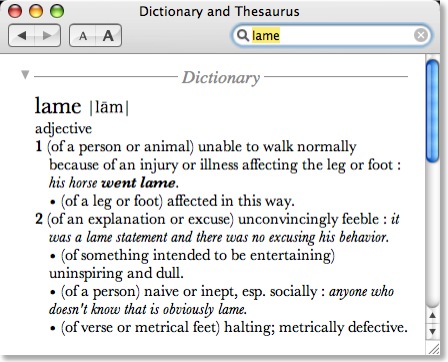
When I read, "They did their lame dance..." I mentally heard the voice of one of the high school students I used to teach saying, "That's so lame" about something he thought was stupid. Now while we might agree that the dance performed by the priests of Baal was ineffective and stupid, and perhaps we might have used the same sentiment as the high school student had we been there, this idea of lame is not what the writer of 1 Kings had in mind. Therefore, I have to assert that the HCSB, while attempting to convey the full meaning of פסח/pasach, falls a bit short because the reading might easily be interpreted as contemporary slang. This reminds me of the decision on the part of the CEV translators to avoid using the word "awesome" for God because of how it is so often misappropriated and overused among teenagers.
In the end, I'll have to conclude that the NLT's rendering is the most accurate: "Then they danced, hobbling around the altar they had made." I still don't know exactly what this dance looked like but I tried to demonstrate my best guess to Kathy. I'm sure my presentation was as comical to her as the priests of Baal's dance was to Elijah. And she agreed, it was lame...
Job and the Golden Earring (Job 42:11)

Our Sunday School lesson this morning focused on the end of the Book of Job, chs. 38-42. While preparing to teach the lesson, I rabbit-trailed my study when I got to Job 42:11.
When I read in the Holman Christian Standard Bible that each of Job's friend's and family gave him a qesitah, I had no idea what that meant. I've read through Job many times, but only started using the HCSB this year. A footnote said that "the value of the currency is unknown" and gave cross references to Gen 33:19 and Josh 24:32. After some quick checking, I found out that no one else seems to know the worth of a qesitah either, but most translations of the Bible do not transliterate it. Rather it's described as "one piece of money" (NASB), "a piece of silver" (NIV/TNIV/NET), "a piece of money" (KJV/NRSV/ESV), "a gift of money" (NLT), "some money" (GNT), and oddly enough, "a sheep" (REB). To me the use of the transliterated qesitah doesn't do anything to enhance understanding of the text and is probably too literal of a translation. One of the other options is probably better (with the exception of "sheep").
The other part of the verse that caught my attention concerned the second gift from Job's friends: a gold earring. I didn't remember Job receiving an earring in my previous studies of the book either. In fact, most contemporary translations simply say that Job received a gold "ring" from his family and friends (NASB, NIV, TNIV, ESV, NRSV, NET, NLT, GNT, REB). Yet, interestingly, the King James Version agrees with the HCSB by also using the word "earring." In consulting the Hebrew, I found that "earring" in the HCSB is from נֶזֶם/nezem. Both the Brown-Drivers-Briggs and the Koehler-Baumgartner Hebrew lexicons suggest that נֶזֶם/nezem refers to either a nose ring for a woman or an earring for either a man or a woman. No mention of a ring for the finger.
But while the translations that simply render the word as "ring" couldn't be considered inaccurate, is it fair to say that when most English readers see the word "ring" in this verse, they think of Job receiving rings for his fingers? My hunch is they do. That makes you wonder why translations after the KJV, especially ones in the last three or four decades would render נֶזֶם/nezem simply as "ring."
No, I don't have a pierced ear myself (and don't ever plan to), but I have to wonder if recent translations haven't tried to gloss over Job's pierced ear. What do you think?
Bible Bias: An Observed Double-Standard
I eventually made my way over to the Bibles. Pretty standard stuff--they had lots of copies of the NIV, KJV, NLT, NASB, HCSB, the Message, a few ESVs, and a small representation of the NAB. One recent translation I noticed absent from the shelves was the Today's New International Version. More out of curiosity than anything else, I asked the more authoritative-looking person working in the store if they carried any copies of the TNIV. She said they didn't have any in stock, but could order anything I wanted. Of course, I wasn't in the market anyway, already having two copies and inquiring simply out of curiosity, so I thanked her, but said it wasn't necessary.
Then, as if to try to demonstrate some knowledge regarding the TNIV, she added that they had received a few copies of the TNIV, but in "polling" (whatever that meant), the local pastors, the TNIV proved too controversial and was viewed with negative criticism. Therefore, they opted not to carry any copies, but she reminded me that any edition could be special ordered.
I looked again at the shelves and saw stacks and stacks of the original NIV, the NLT and the Message. Exactly what in the TNIV was so controversial? Was it the fact that the TNIV is not a formal-equivalent version of the Bible? If so, neither were the majority of the Bibles on the store's shelves. Was it the use of inclusive language for humans when the context of the audience was both male and female? Then why carry the New Living Translation and the Message, both of which do the same thing? Was it because the NIV is so firmly entrenched that people are resistant to any revision--in spite of the fact, that the TNIV is only 7% different from the NIV, and most of the changes are a vast improvement in terms of translational accuracy? Not to mention the fact that the TNIV is often less dynamic in places than its predecessor.
I knew the answer, of course. It was the second option regarding the firestorm of criticism over the use of gender-inclusive--or gender-accurate (the term preferred by the TNIV translation committee)--language. But this is such a double-standard. The NLT in both the 1996 and 2004 editions have used inclusive language, and it far outsells the TNIV. The CBA sales results for July, 2006, show the NLT as the #4 best-selling Bible version while the TNIV isn't even in the top ten:
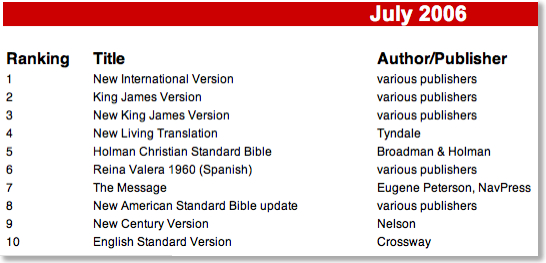
I find it disheartening to see a good translation like the TNIV suffer from a smear-campaign of misinformation even in my hometown. Maybe that's strong sentiment, but I don't know how else to explain why the TNIV would be shunned while the NLT would be embraced, when they both contain the same supposed controversial features. Why would a store not carry the TNIV because of inclusive language, but continue to carry the New Living Translation, the Message, the Good News Bible, the New American Bible, and the New Revised Standard Version? I simply don't understand.
To that effect, I very politely said to the woman running the store that anything controversial in the TNIV is also found in the New Living Translation. She shrugged her shoulders and said, "You're right, but some people can't even let go of the King James Version yet." She's correct, of course, but as we approach the 400th anniversary of the KJV, maybe it's time for us to move on..regarding a lot of things...
Is a Paraphrase in the Eye of the Beholder?

First of all, I didn't mean anything negative when I called the NLT an extreme meaning-driven translation. But perhaps I am guilty of poor communication. All I meant was that on the scale from very literal vs. very free, the NLT would be on the extreme side from the NASB. And for what it's worth, I was NOT factoring in paraphrases at all. In reflection, I may have made a poor choice in selecting a chart from a publisher's website. If you notice the chart above, what it does is place the NLT directly in the middle which gives the impression that the NLT is a "middle-of-the-road" translation. Personally, I don't think it is. To me, the NIV is a better candidate for the middle position. Of course, Tyndale refers to the NLT as a "thought-for-thought" translation, too, and they've put that in the heading of their chart which might also be a way for them to equate the NLT as the standard for all meaning-driven translations. I would not personally construct a chart quite like this, but then again, I'm not trying to market a Bible.
Anyway, in part of my response in the comments, I referred to a similar-in-concept, but different-in-result chart on p. 66 in David Dewey's book, A User's Guide to Bible Translations. Below is a scan of Dewey's chart regarding the span of Bible versions. If you have trouble viewing it, a larger version can be found at this link.
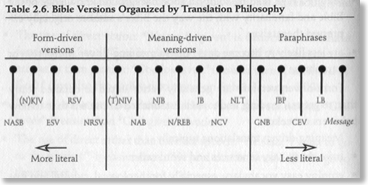
In looking at Dewey's chart, I came across something that intrigued me even more. Although I had seen this chart before, I never noticed that Dewey categorizes the Good News Bible and the Contemporary English Version as paraphrases. While I would consider the GNB and CEV very free dynamic equivalent or meaning-driven translations, I would have never thought of them as paraphrases, proper. In fact, although I haven't spent as much time with the CEV and can't speak for it as much as I could the GNB, I would have placed the New Living Translation to the right of both of these on the scale as being even freer. In my reading, the NLT comes closer to being a paraphrase at times than these other two, although I would still categorize all three as translations.
All of this begs the question as how one distinguishes between a translation and a paraphrase. It's almost like the famous quote from the Supreme Court justice who said in regard to pornography, "I may not be able to define it, but I know it when I see it!" To me, the GNB and CEV do not rank with what I think of as paraphrase (and neither does the NLT, which again, in my view is freer than these other two). However, the other three that Dewey includes in his chart--the J. B. Phillips NT, the Living Bible, and the Message--certainly do rank as paraphrases in my mind (although the JBP less than the other two).
So how does one designate a work as a paraphrase in distinction to "an extreme meaning-driven" paraphrase? On p. 42 of Dewey's book, he writes, "Strictly speaking, a paraphrase is not a translation from one language to another, but a rewording in the same language." Of course, Dewey admits that this definition doesn't cover Phillips' NT or Peterson's The Message since they were both rendered from the original languages. To allow for this, Dewey then further defines a paraphrase as "any free rendering, regardless of whether it was made from another English version or from the Greek and Hebrew." I suppose that such a broad definition would then allow one to include the CEV and GNB as a paraphrase, but then again, why not the NLT, too? The real question for Dewey would then have to be how he is defining "free" in the qualifying definition. Interestingly, in his section about paraphrases on pp. 42-43, Dewey does not include the CEV and GNB in his discussion, but he does mention the Living Bible, The Message, and J. B. Phillips' New Testament. On p. 203, Dewey says that a paraphrase such as the Message should never be used as a principle Bible, but if he considers the CEV and the GNB to be paraphrases as well, would he say the same thing about these versions? Many people do, in fact, use these two "translations" (my designation) as their primary Bible.
Perhaps, indeed, the Supreme Court justice's words do apply to this. What do you think? How does one distinguish between a translation and a paraphrase? Are freer translations like the GNB, CEV or NLT suitable as a primary Bible? Feel free to share your opinions in the comments.
Incidentally, although I'm nitpicking Dewey's definition of a paraphrase, I highly recommend this book as being one of the most current surveys available for all the options in Bibles out there today.
Top Ten Bible Versions: A Few Introductory Words
Regardless, I'm not all that upset that I haven't been able to abandon translations for the original languages. On one hand, besides the naive assumption that I would ever be able to read exclusively from the Greek and Hebrew, there was also an assumption that I would be able to create meaningful translation on the fly in front of a group. If you've ever attempted to do this, you know it's easier said than done.
On the other hand, I really enjoy reading and comparing translations of the Bible. Precise translation excites me. Clever translation impresses me. I read through translations devotionally. I began collecting translations years ago, and frankly I can't imagine ever being at a point where I would not be using them and interacting with them--regardless of any level of proficiency with the original languages.
People get quite attached to translations of the Bible. There are KJV-only people for instance. Some are KJV only because they think that's the original Bible and it holds some special divine authorization. Others are KJV-only because they hold to the Textus Receptus manuscript tradition. Although, I'll be honest--I've never quite understood why those who hold to the Textus Receptus don't favor the New King James Version over the KJV. Most whom I've known who claim allegiance to the TR still favor the KJV. I've also known some who hold to the Majority Text, but what version would they use then? There's actually no major English translation based on the Majority Text, so most of them will still use the KJV. And of course, some hold on to the KJV simply because they like it best. It's this latter form of KJV readers that seem a bit more palatable.
A few years ago when I was in my twenties, a pastor took me under his wing and began incorporating another seminary student and myself in the worship services, letting us preach regularly or read the Scripture passage for the week. This pastor was older and exclusively used the KJV in his messages. However, my friend and I always read from the NASB or NIV, and we had never been told to do otherwise. Then we had a member who had been active for decades decide he was leaving the church because we were reading from a translation other than the KJV. It turns out that when he was a young man and the then-newly-published Revised Standard Version was giving cause for controversy, he made a vow to never read or allow to be read to him a different translation than the KJV! The pastor tried to reason with him, as did the head of the deacons. But he refused to budge. He had made his vow to God, by Jephthah! I was certain that the pastor would cave and tell us from now on to use the KJV, but to my amazement, he decided to let this member go. I've always had great respect for him because of that.
Anyway, it makes me wonder if in a few decades we'll see NIV-only or ESV-only adherents. I'll admit that I went for twenty years studying and teaching exclusively from the New American Standard Bible. Yes, as described above, I appreciated other translations, and other translations interested me, but overall I was convinced that the NASB was the best translation, period--for me, for you, for everyone. I didn't necessarily voice that sentiment, but my actions demonstrated it. Obviously, I no longer think that way, but I'll talk more about that when I get to the entry on the NASB.
Yet, I've never belittled anyone for using a particular translation or accused someone of having aberrant beliefs based on what version of the Bible he or she used. I'm greatly disturbed that Evangelicals are arguing with each other over translations of the Bible, particularly the TNIV which isn't even on the June top ten list from the Christian Booksellers Association (see below). In fact, if you look at that list, all the English translations represented are Evangelical translations. We read the Bible more than any other group in all of Christendom if these figures are any indication.
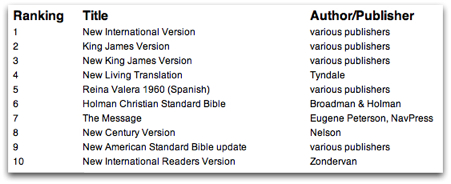
To say that "The best translation is the one you'll read" might sound cheesy to some, but I really believe that. I have 84 distinct English translations, and off the top of my head, there are only about two that I would seriously not recommend under any circumstances (the New World Translation and the Inclusive Version NT). Some are obviously better than others. I believe I can make a case as to why newer translations in general should be favored over older translations. But hey, if the KJV speaks to you, reading that is better than reading nothing. However, people get really upset over translations, even translations that are being read by others. It's not like anyone makes you read a particular translation. Right now, the TNIV seems to be the negative target of choice, and I really believe the issue is totally overblown. I'll explain more when I write my entry on the TNIV.
If you read my initial post where I announced this series and the top ten versions I am going to write about, you'll notice in the comments where people question WHY I didn't include this or that translation. It's my list, for the love of Margaret! Others are free to write their own list.
Regardless, I may have made a mistake in ranking these from 1 to 10. The first three probably are truly ranked in my mind in terms of my use and admiration of them. However, think of all of them as categorical favorites. The Revised English Bible has some of the best literary qualities, especially for oral reading, for instance. The Wycliffe New Testament is one of my favorite Bibles in the historical translation category. The New American Standard is my favorite formal equivalent translation in the Tyndale tradition. The Message is my favorite paraphrase. You start to get the idea.
So here we go. All of these blog entries are my subjective takes on why these particular Bible versions stand out to me. The exclusion of any particular translation is not a knock against it. Don't take it personal! I'll begin with the Holman Christian Standard Bible followed by the other nine in my list and a few honorable mentions to boot.
By the way, in case you missed it, these are the versions that I'll be covering:
1. Holman Christian Standard Bible
2. Today's New International Version
3. New American Standard Bible
4. New Living Translation
5. The Message
6. Revised English Bible
7. New Jerusalem Bible
8. Good News Translation (Today's English Version)
9. The Wycliffe New Testament (1388)
10. Modern Language Bible (New Berkeley Version)
Honorable Mention #1: New English Translation
Honorable Mention #2: King James Version
Honorable Mention #3: The Cotton Patch Version
Redacted 5/23, 10:00 AM
Top Ten Bible Versions: My Picks
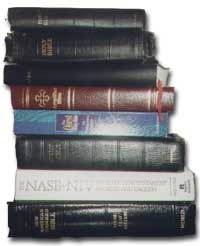
The next few days are quite busy for me, but sometime next week, I plan to begin a series that explores a number of my favorite translations. I don't intend to provide exhaustive analysis of these versions. That's been done elsewhere, and it's doubtful that I could provide significant new insights. However, I can relate what's peculiar (meant in the good sense) about these versions that make them stand out to me.
Below is my top ten list of versions that I'll be exploring in future blog entries. The top five are pretty set in my mind right now. These are the ones that I mainly use. Below that, the list is fairly fluid. Some people who know me may be surprised at some of the versions I've included. If that's the case, stay tuned for my explanations beginning next week.
1. Holman Christian Standard Bible
2. Today's New International Version
3. New American Standard Bible
4. New Living Translation
5. The Message
6. Revised English Bible
7. New Jerusalem Bible
8. Good News Translation (Today's English Version)
9. The Wycliffe New Testament (1388)
10. Modern Language Bible (New Berkeley Version)
Honorable Mention #1: New English Translation
Honorable Mention #2: King James Version
Honorable Mention #3: The Cotton Patch Version
An eclectic selection, don't you think?
Point of Clarification: When I refer to these as my top ten favorites, it's my top ten out of the 80+ distinct translations that I have accumulated over the last twenty years or so. Click here to see the full list.










